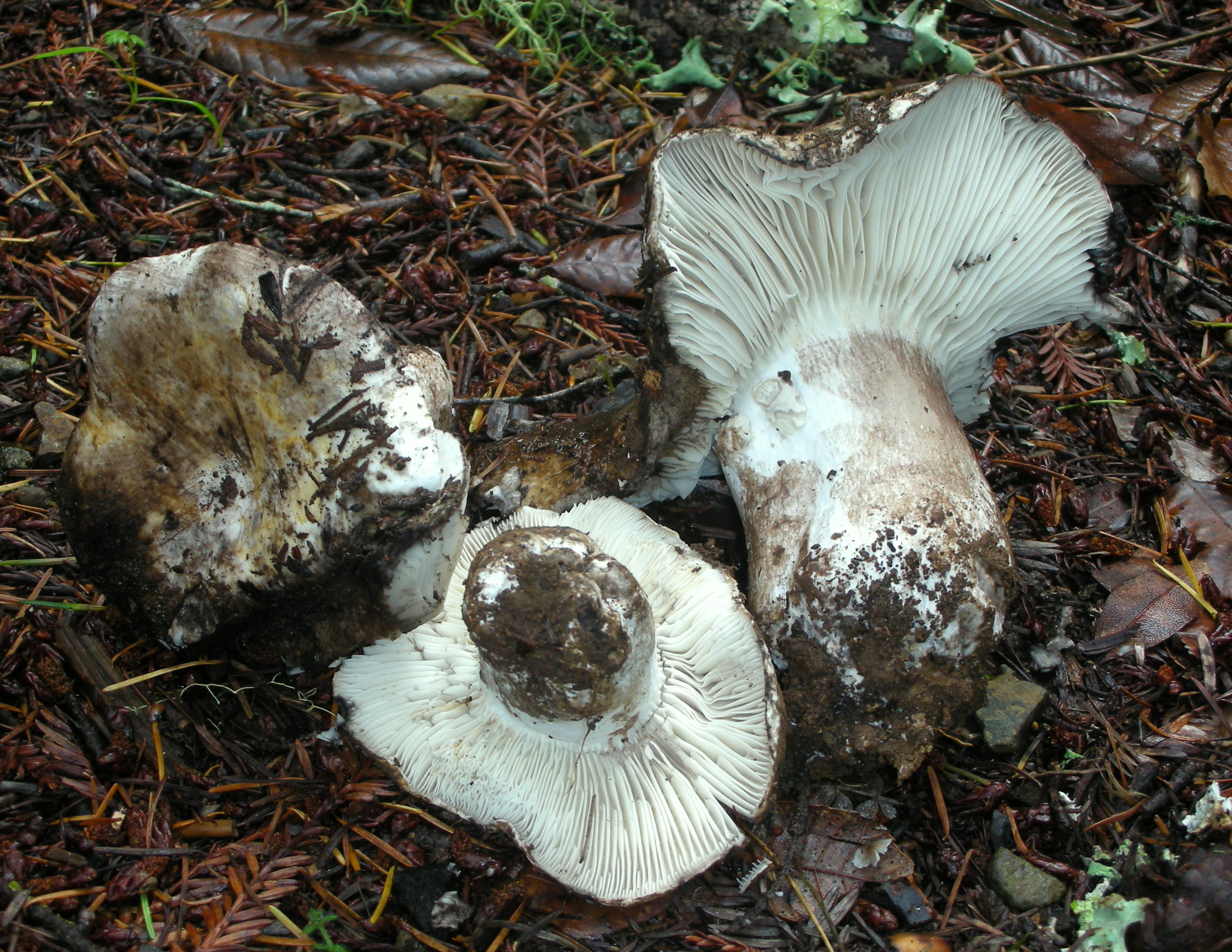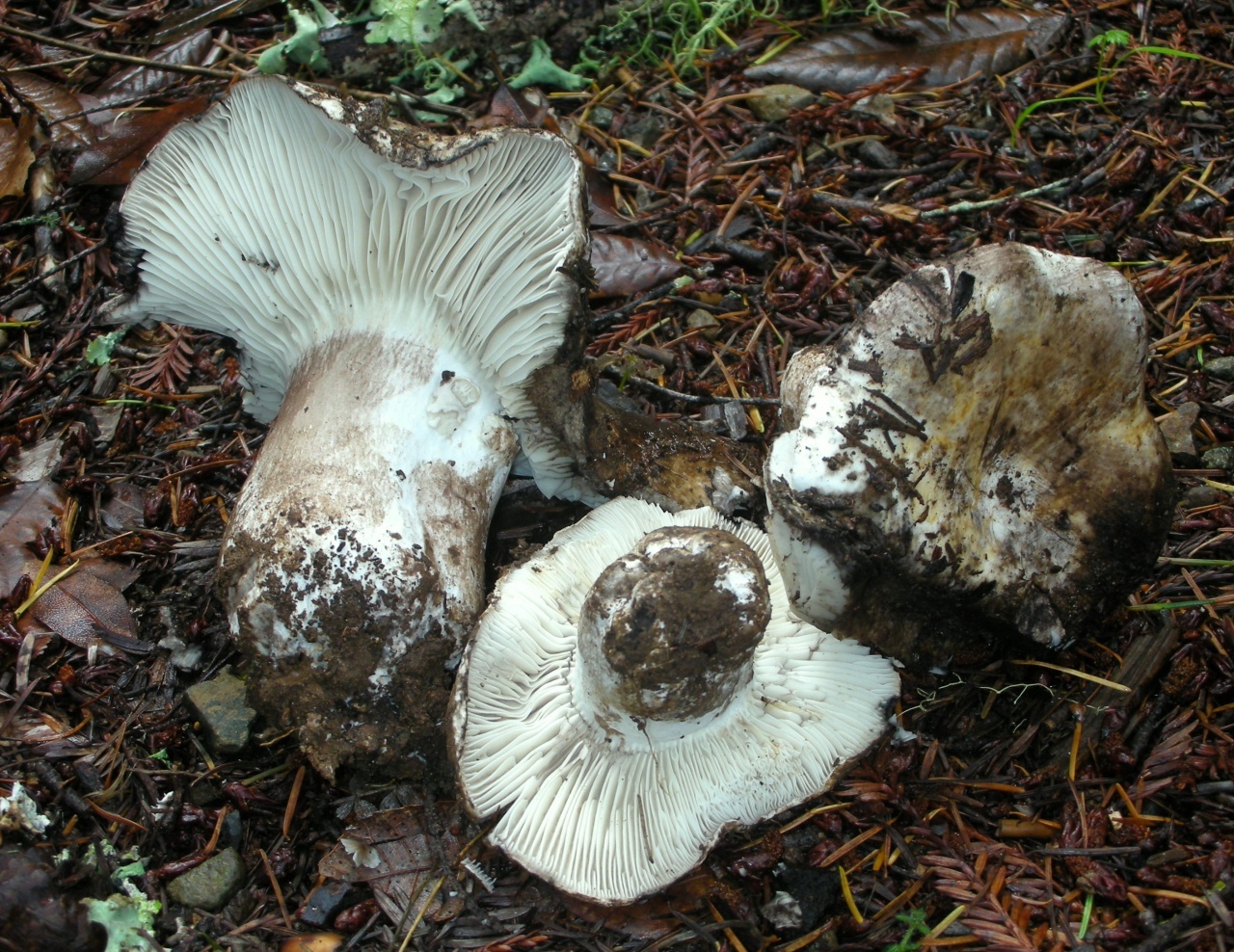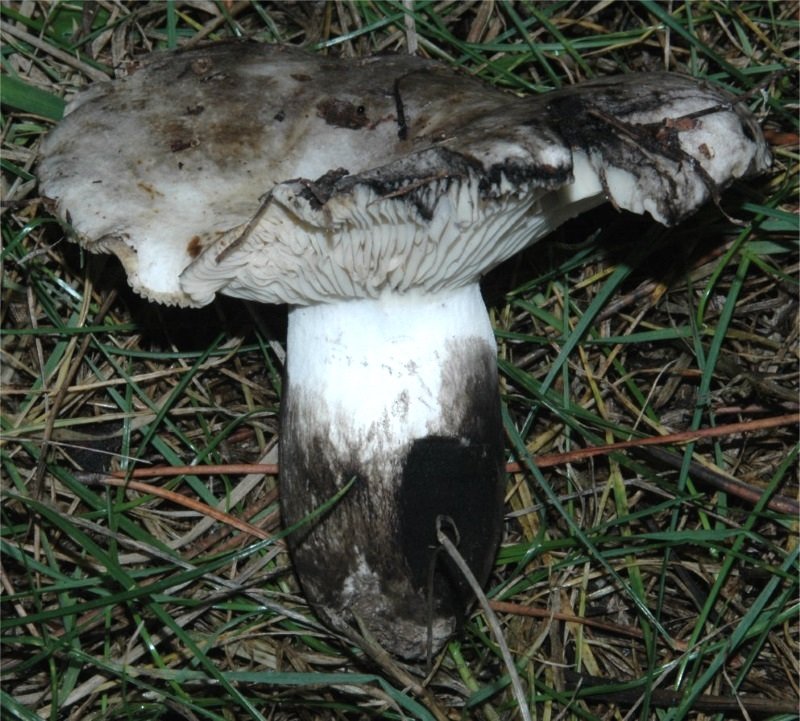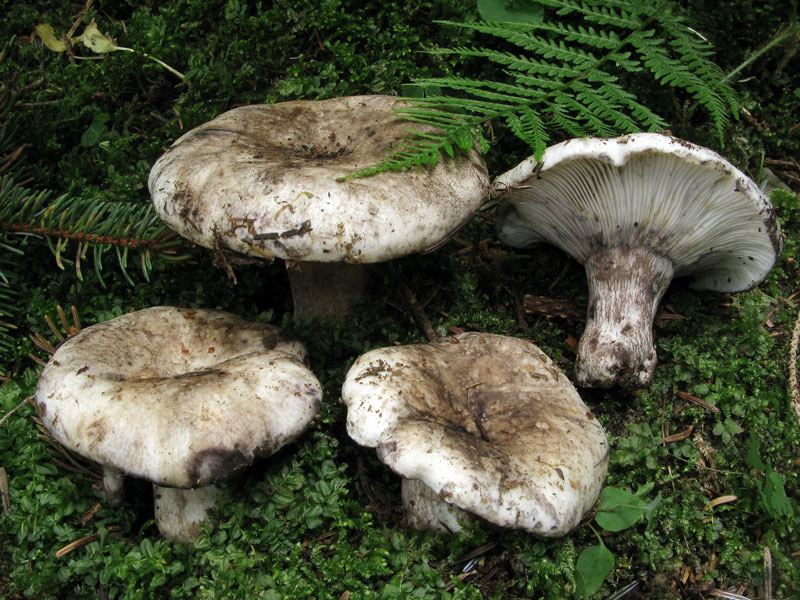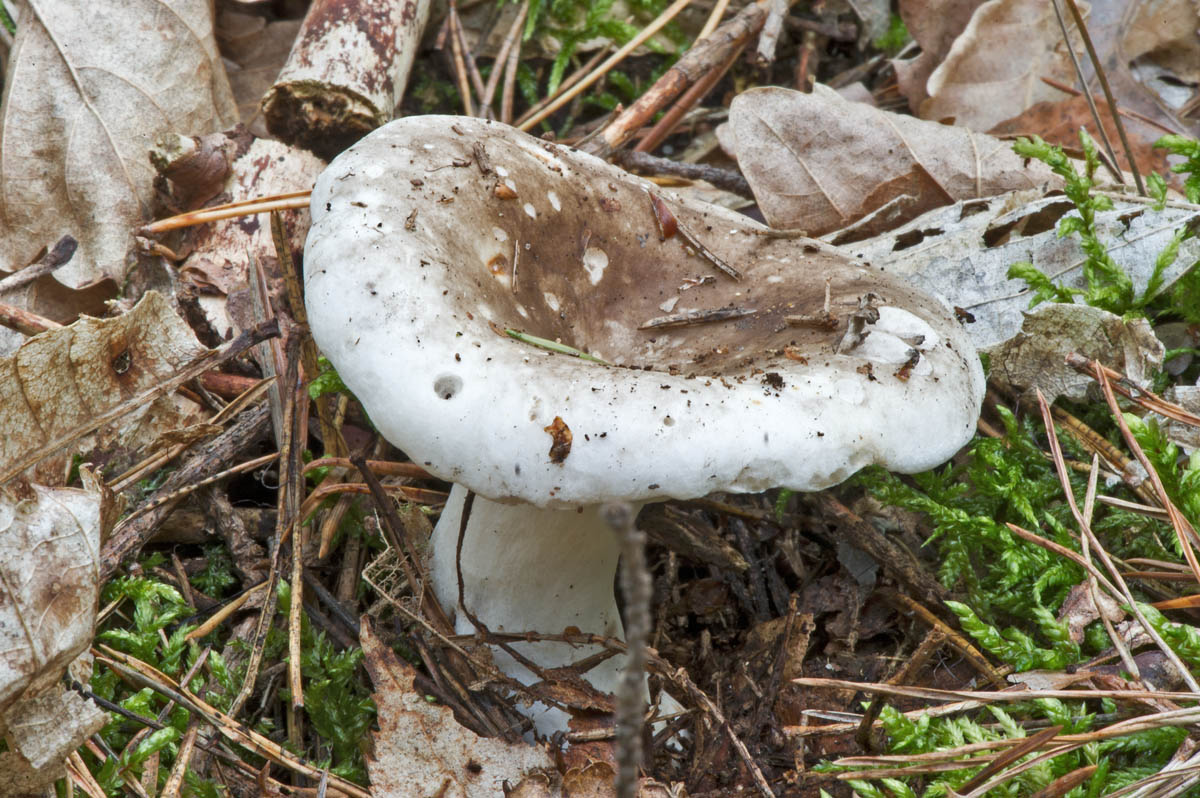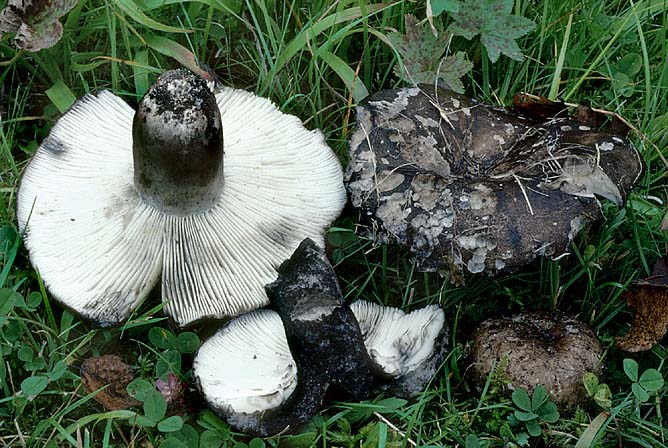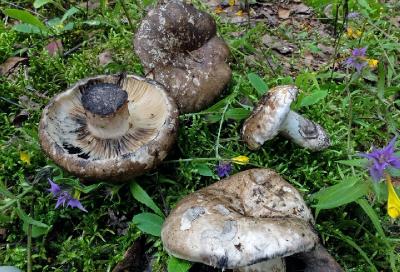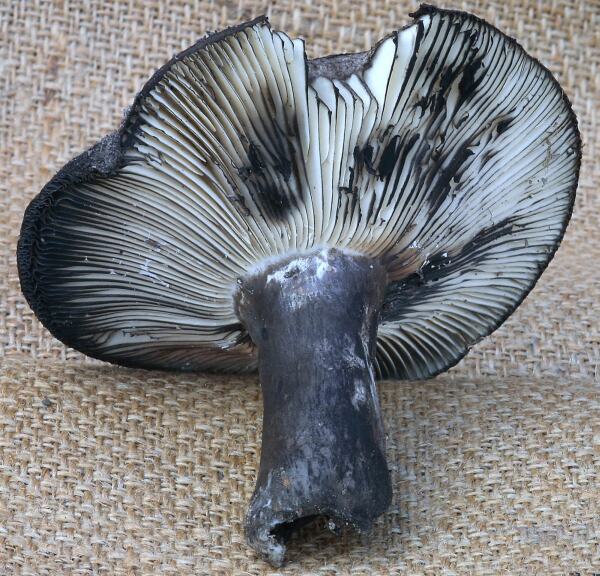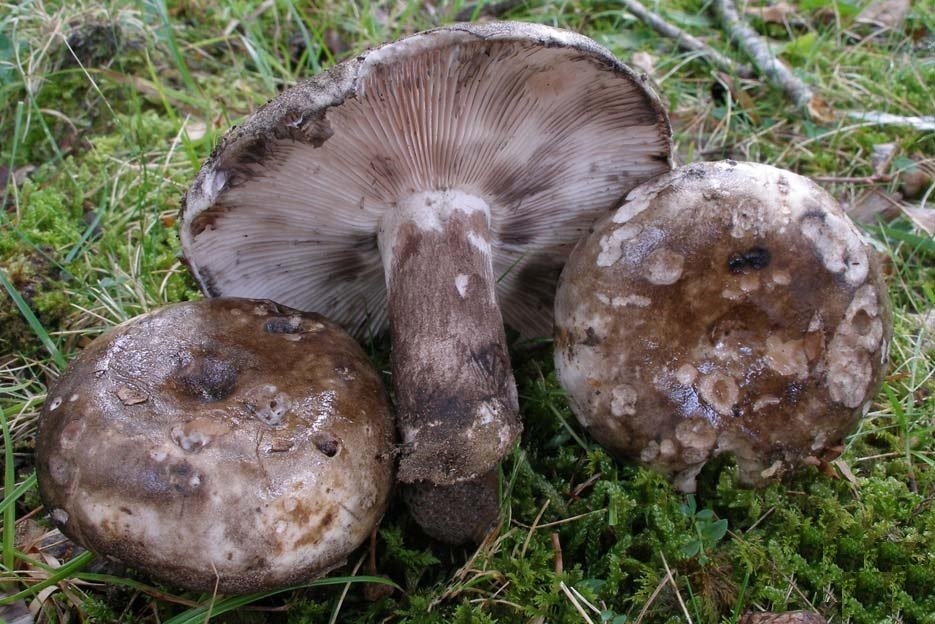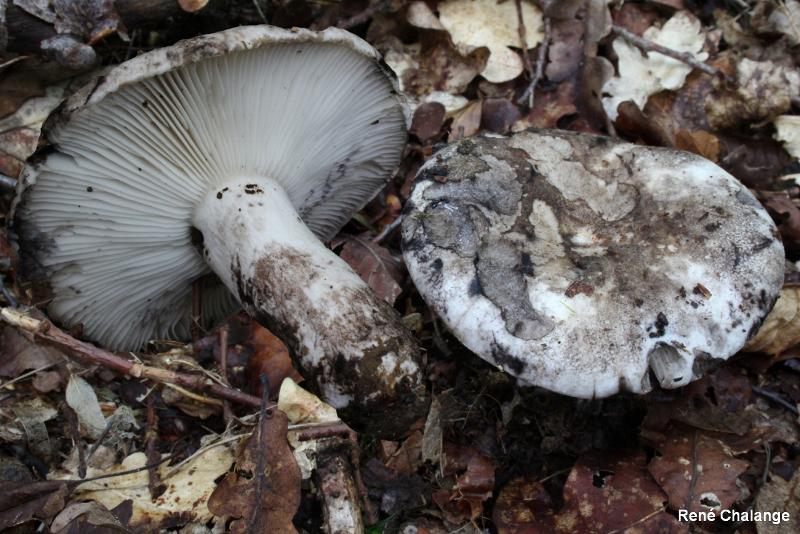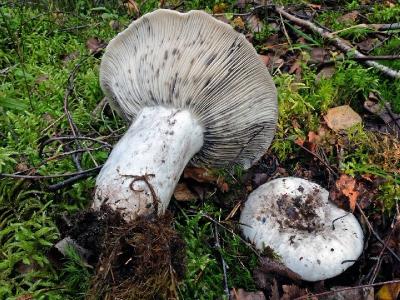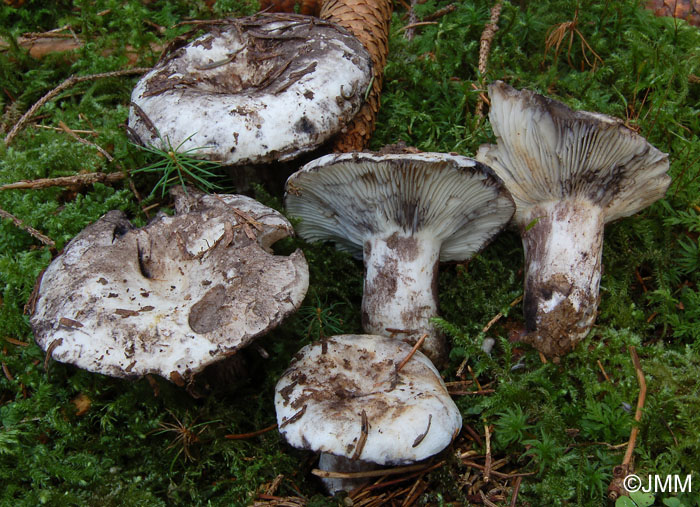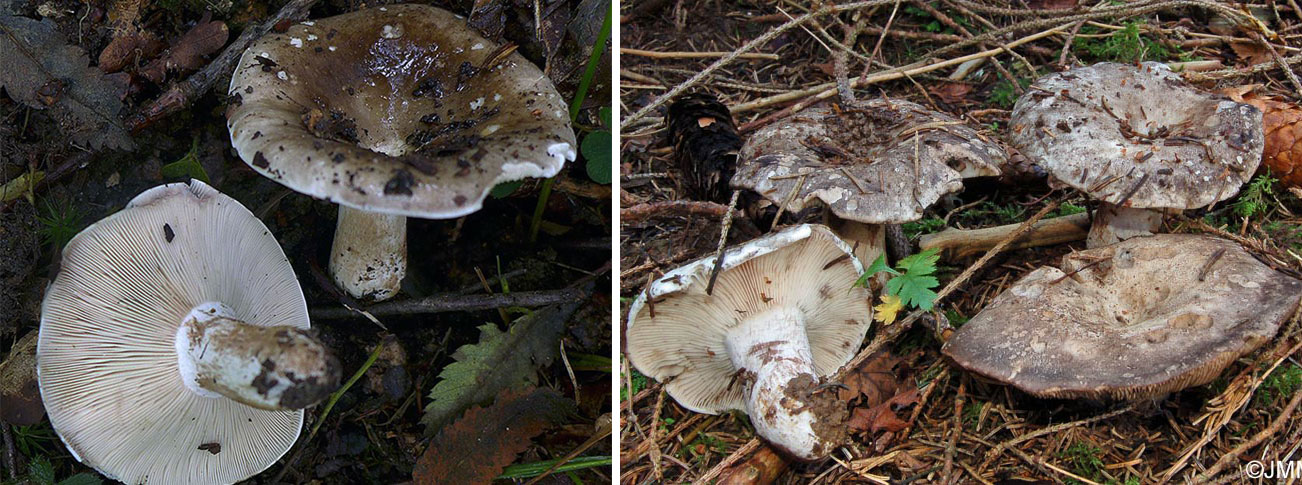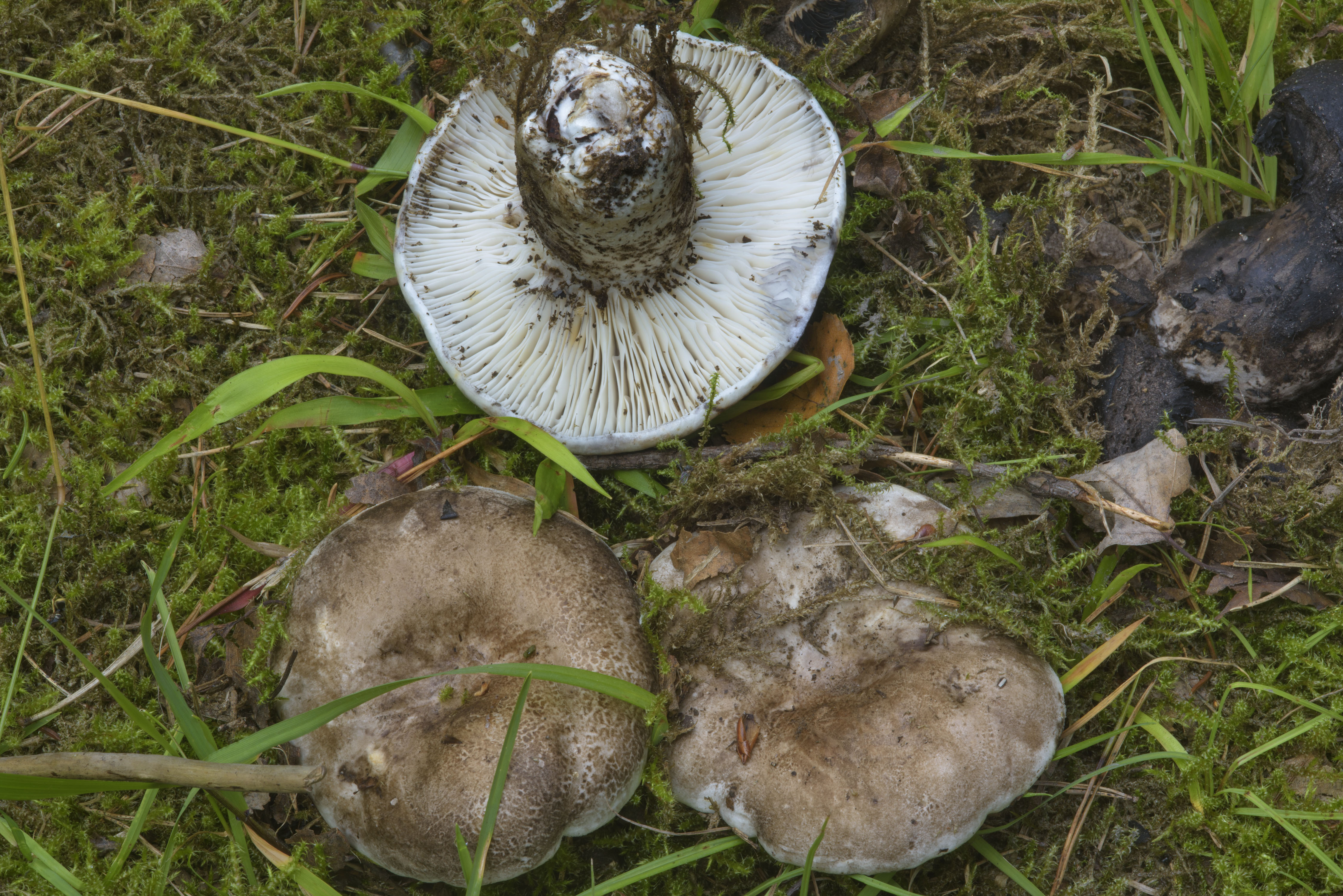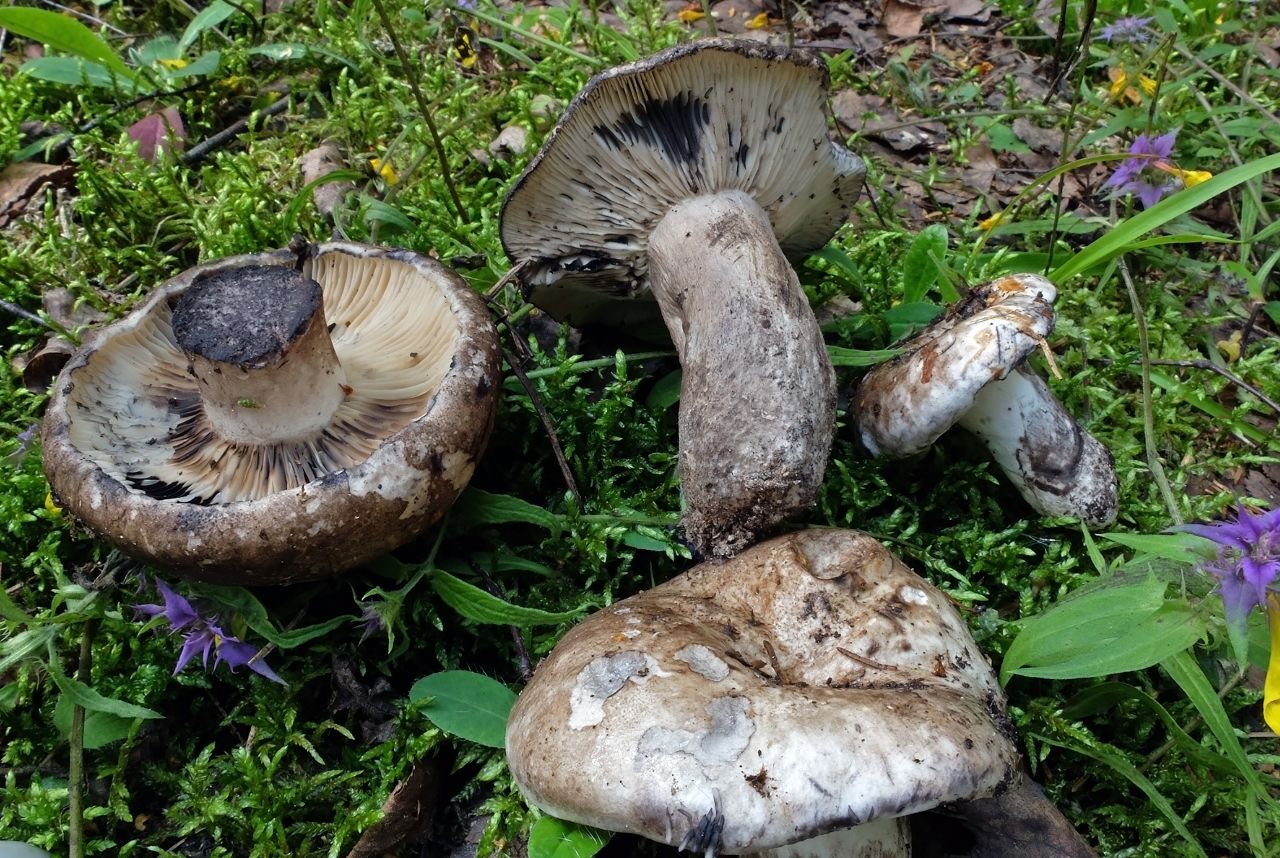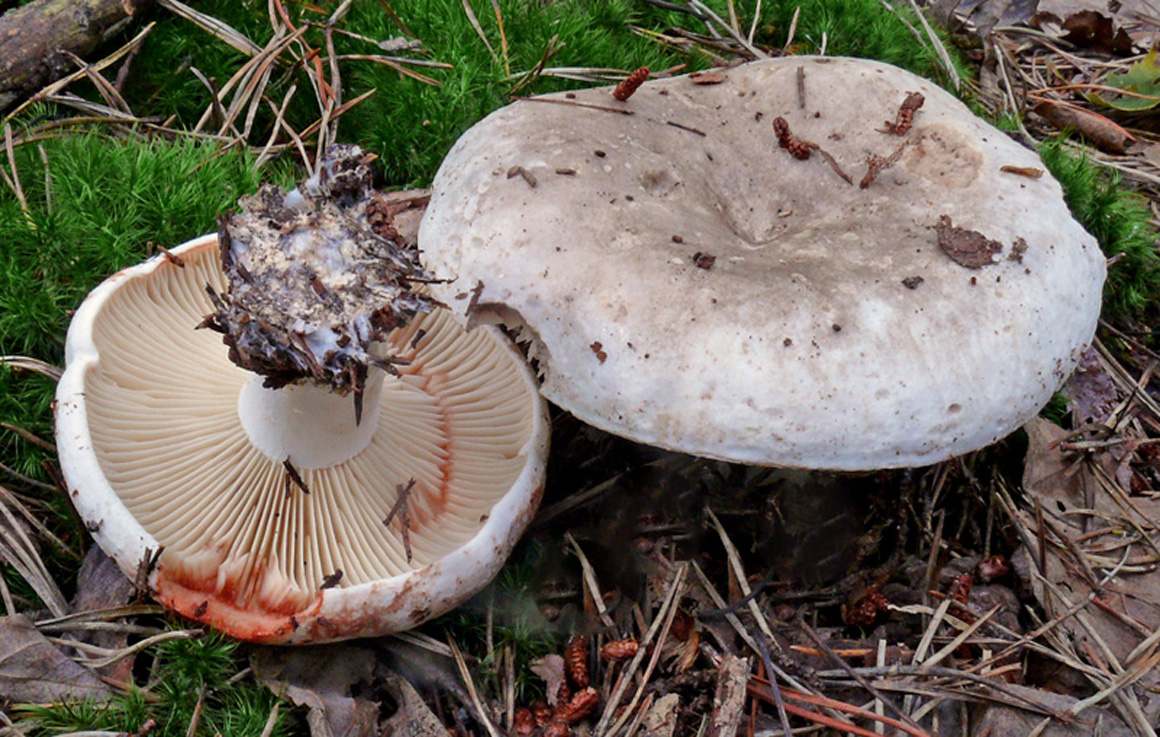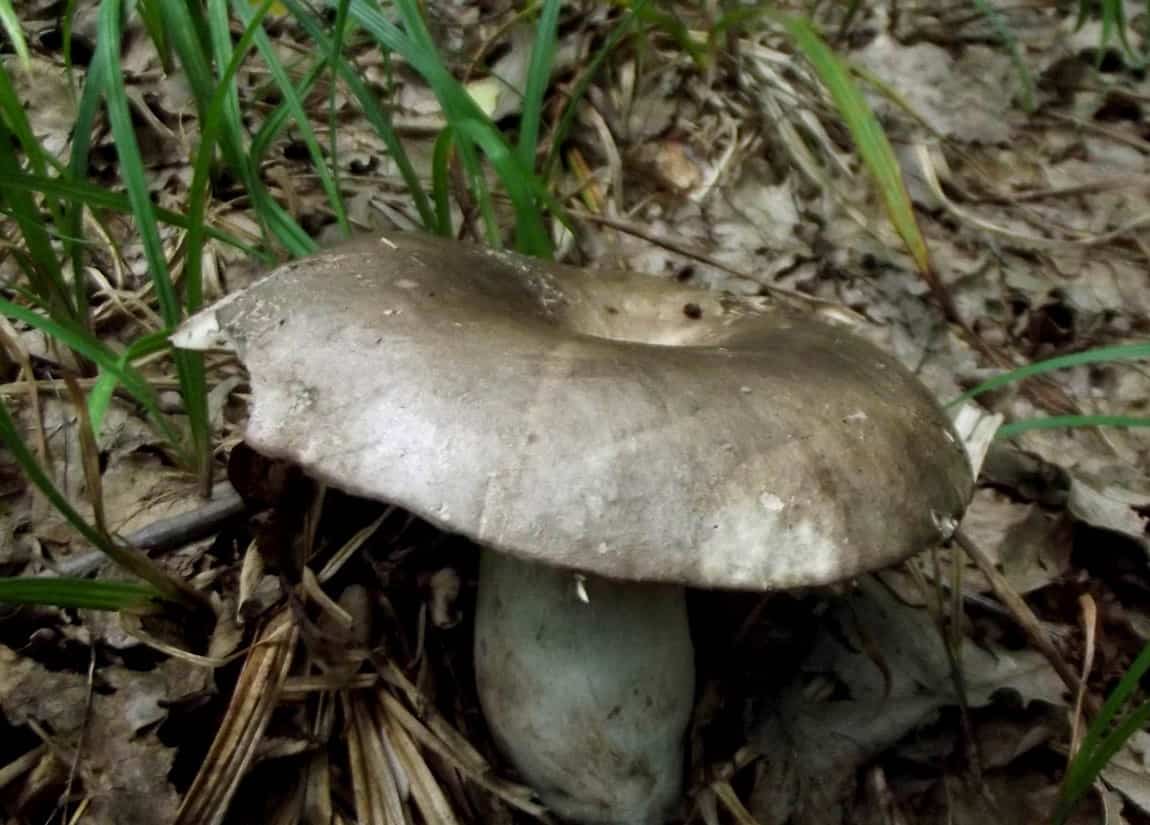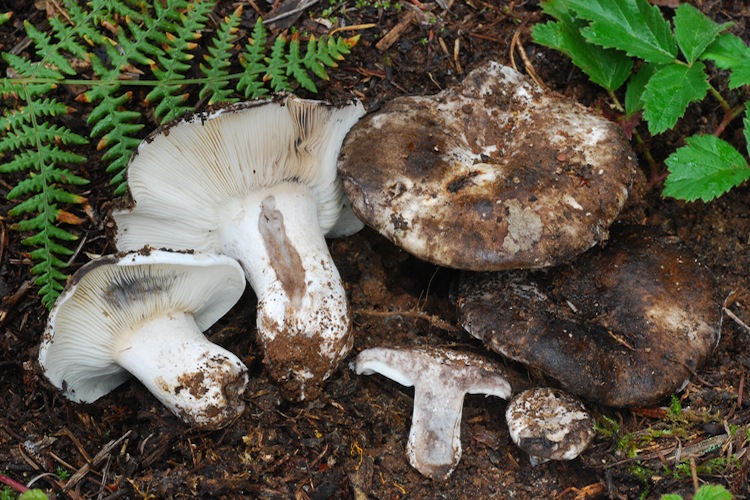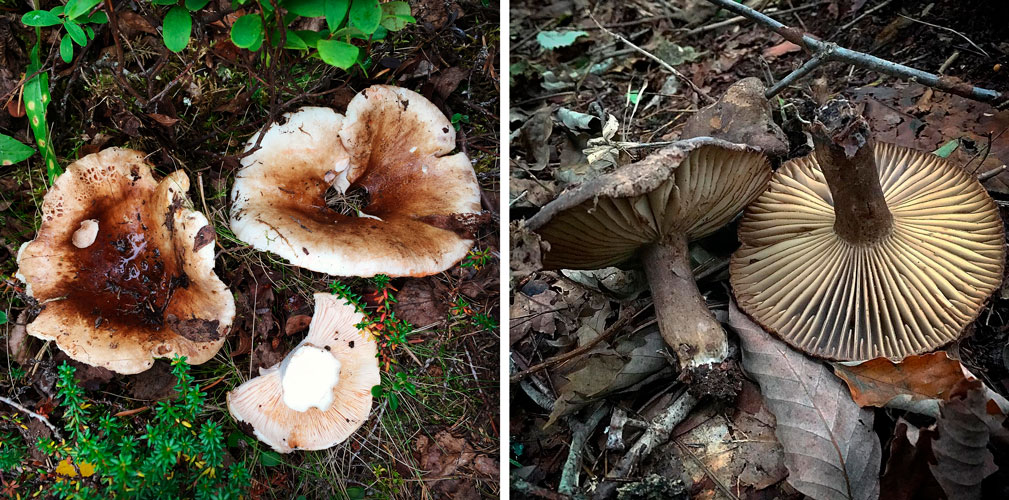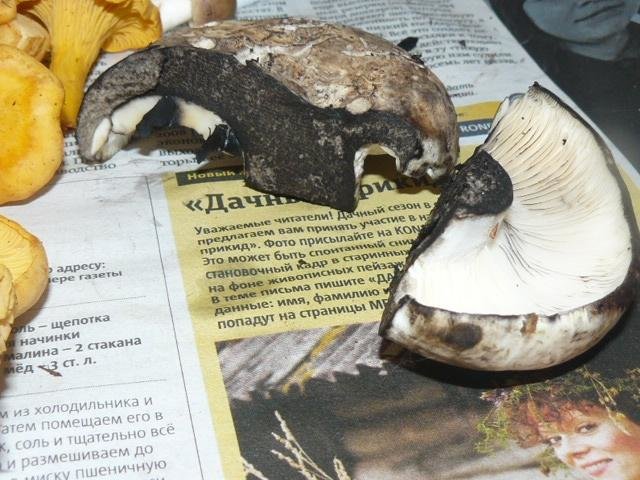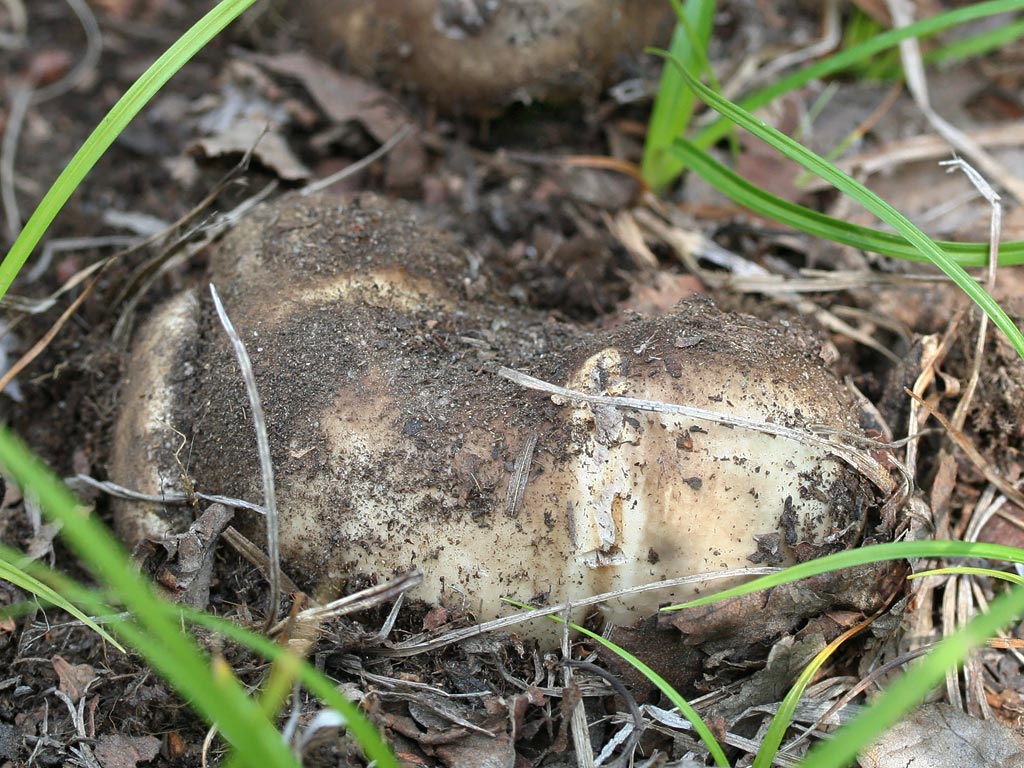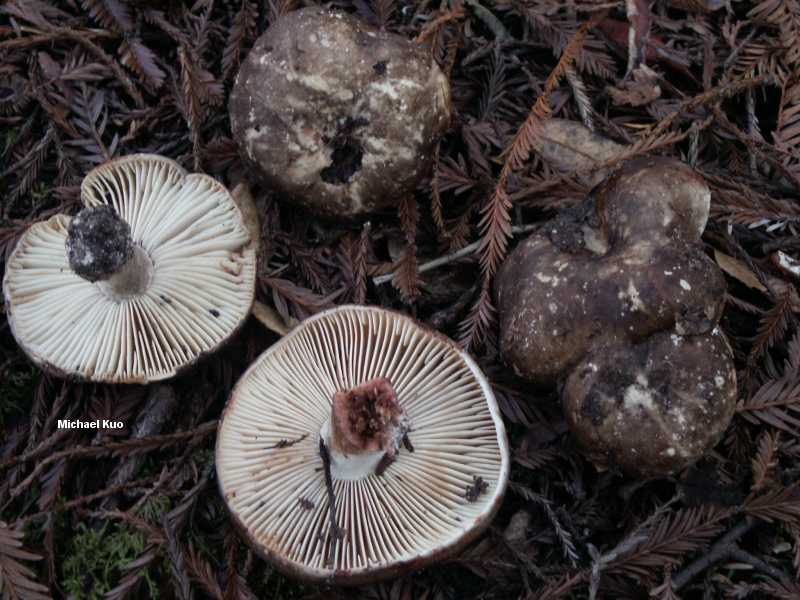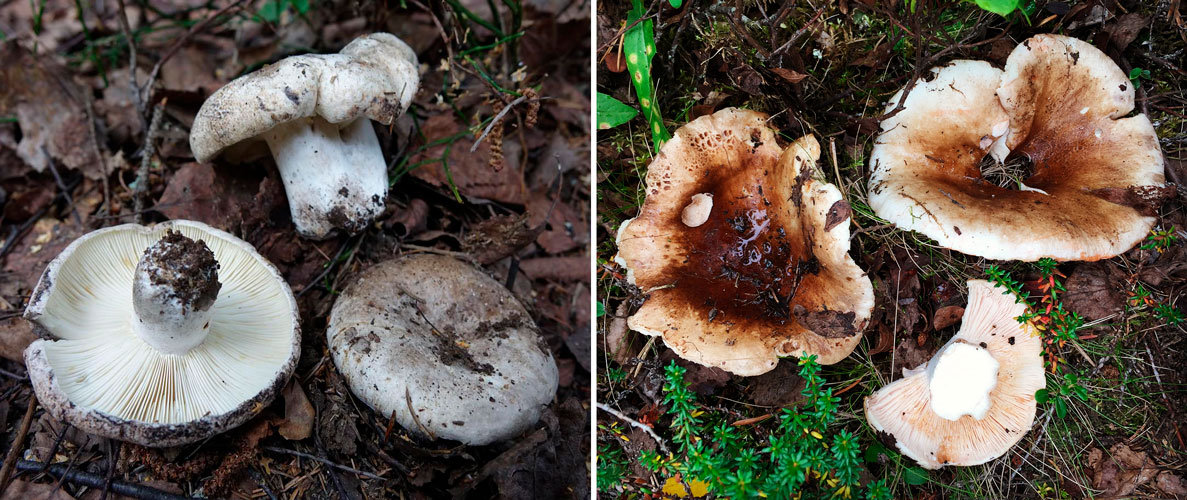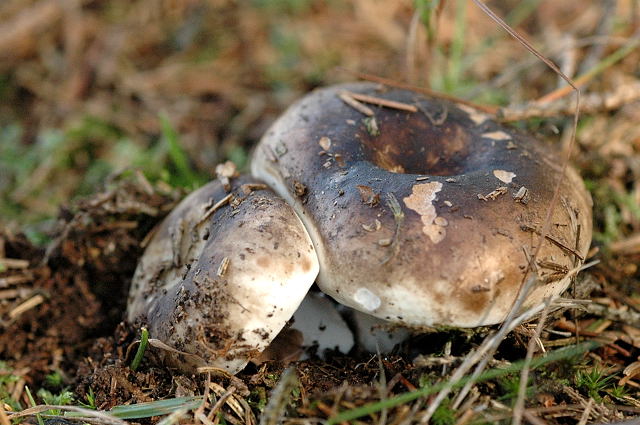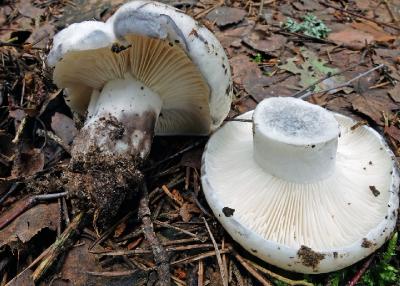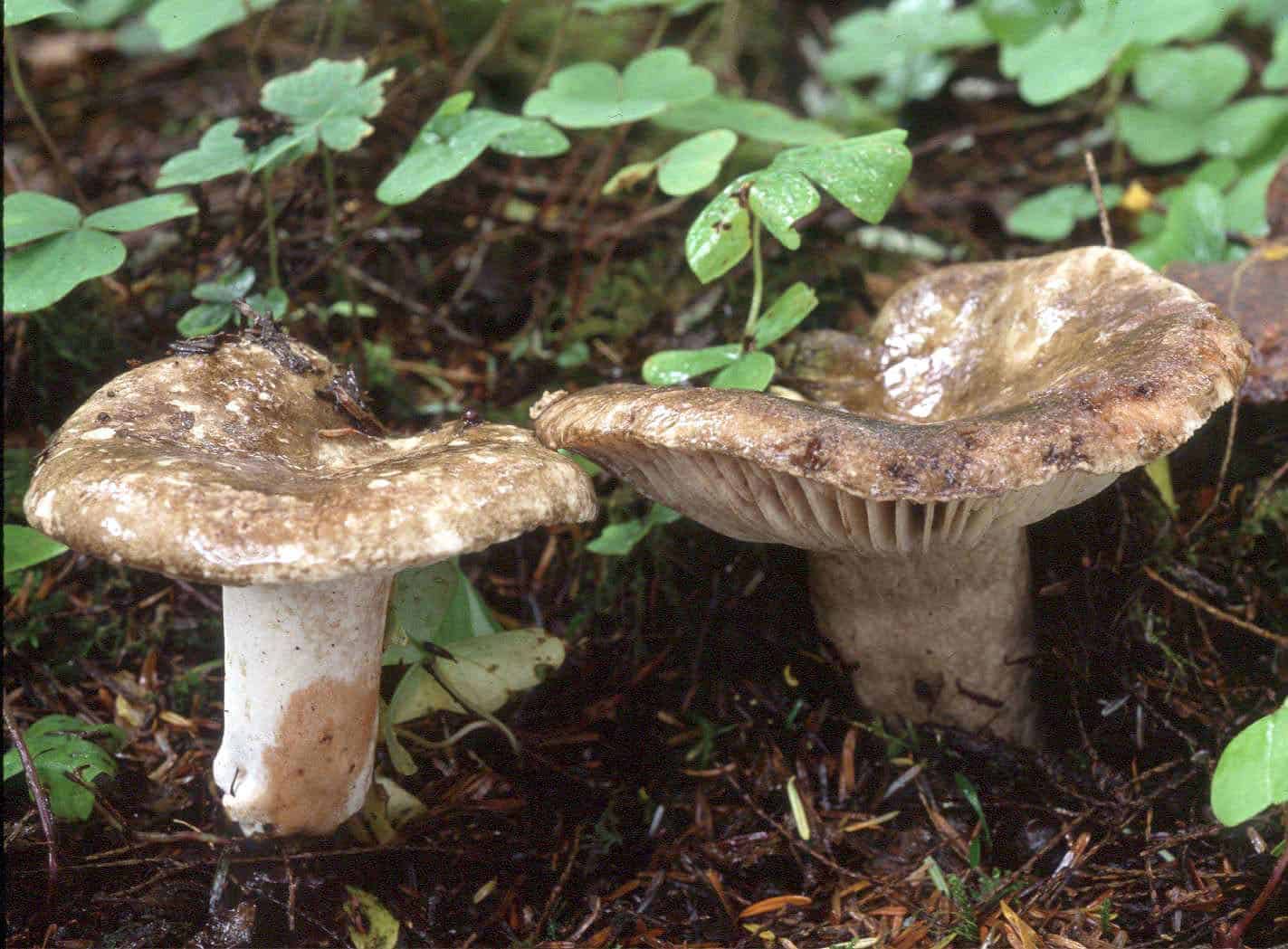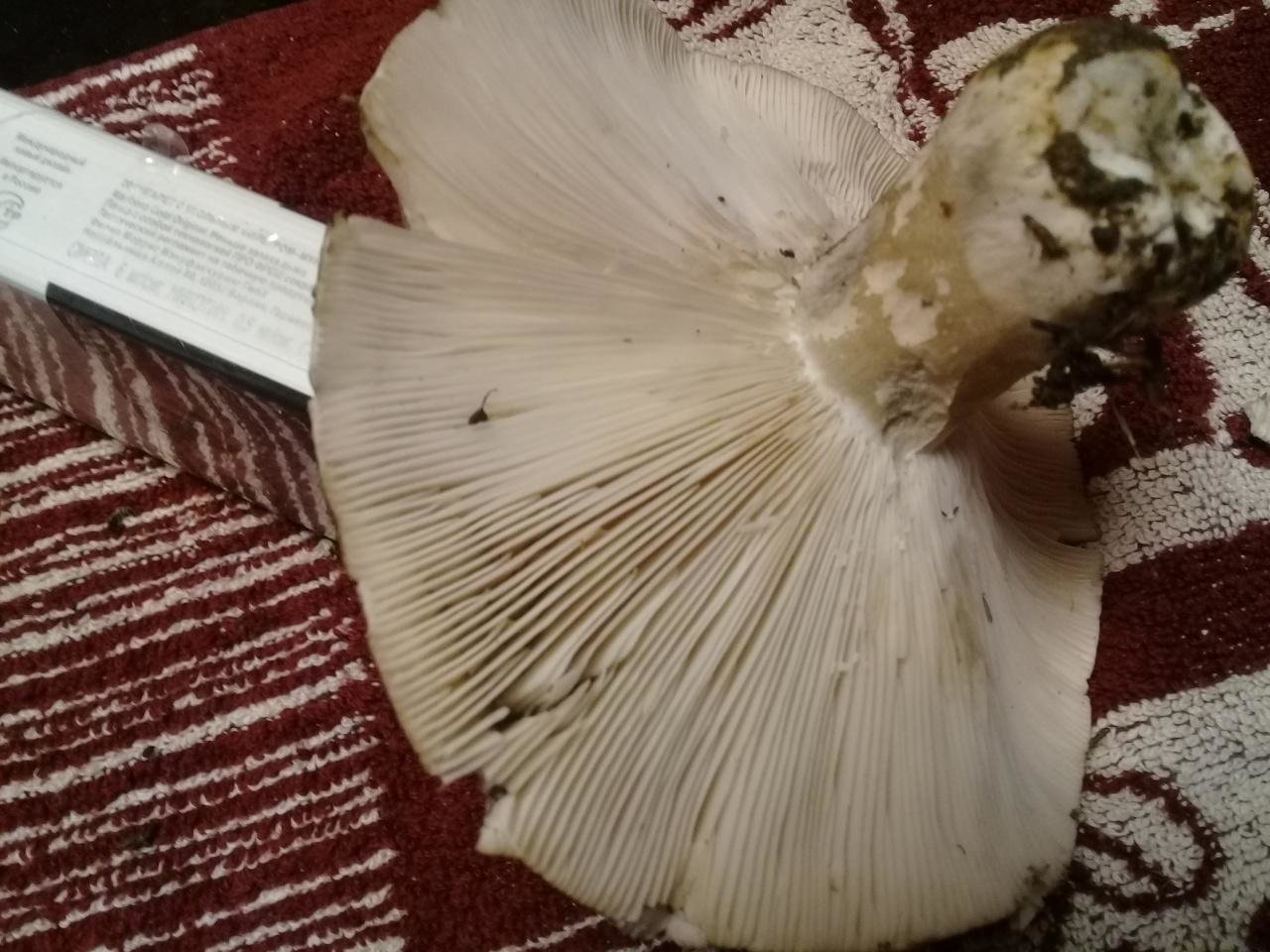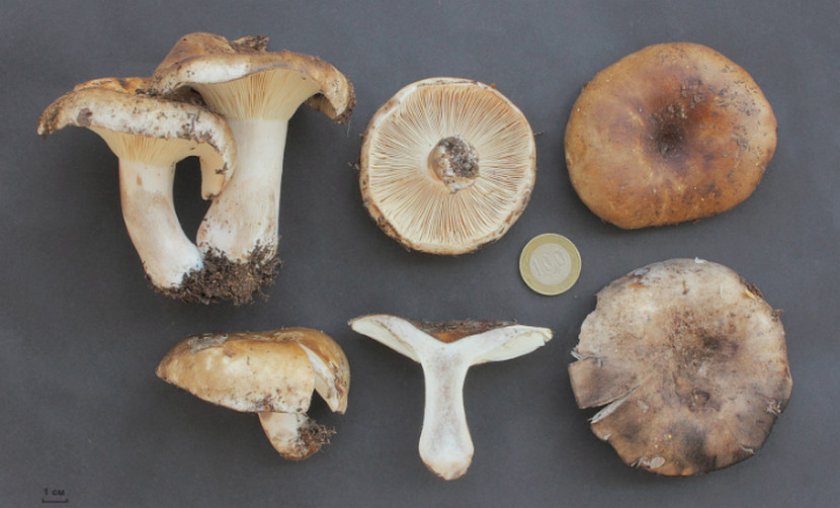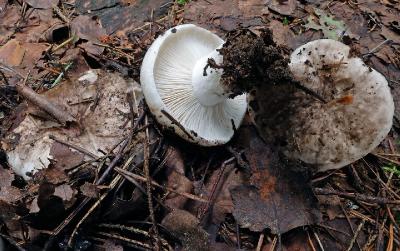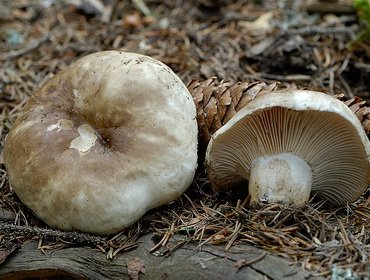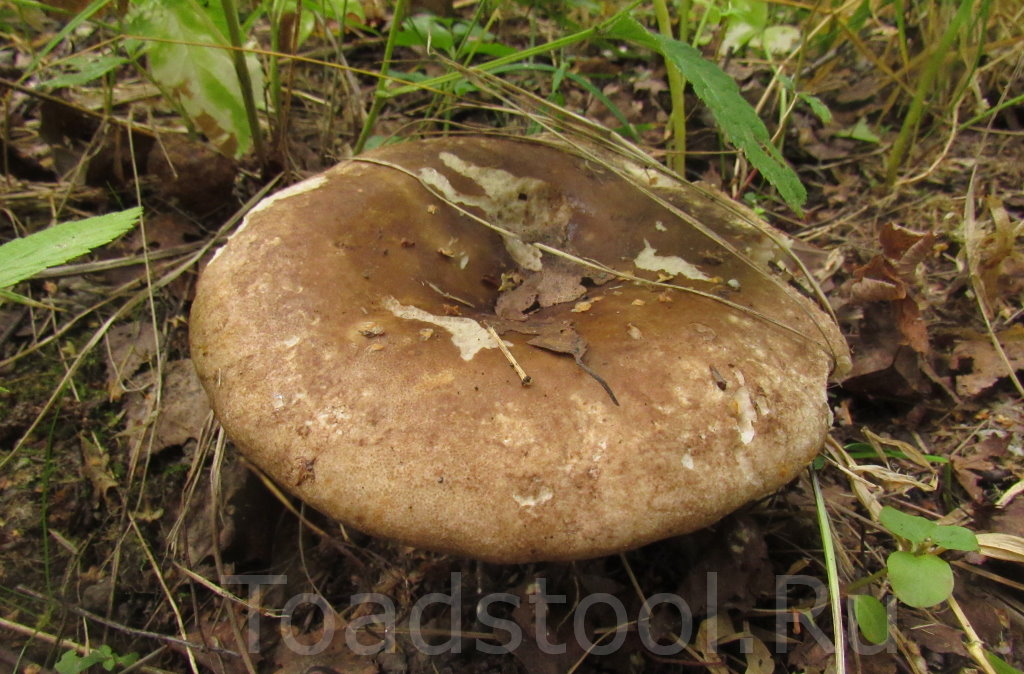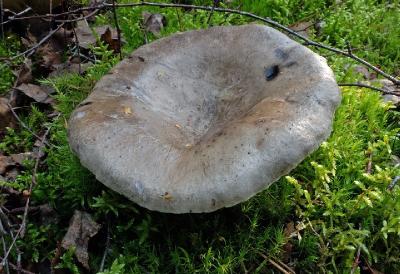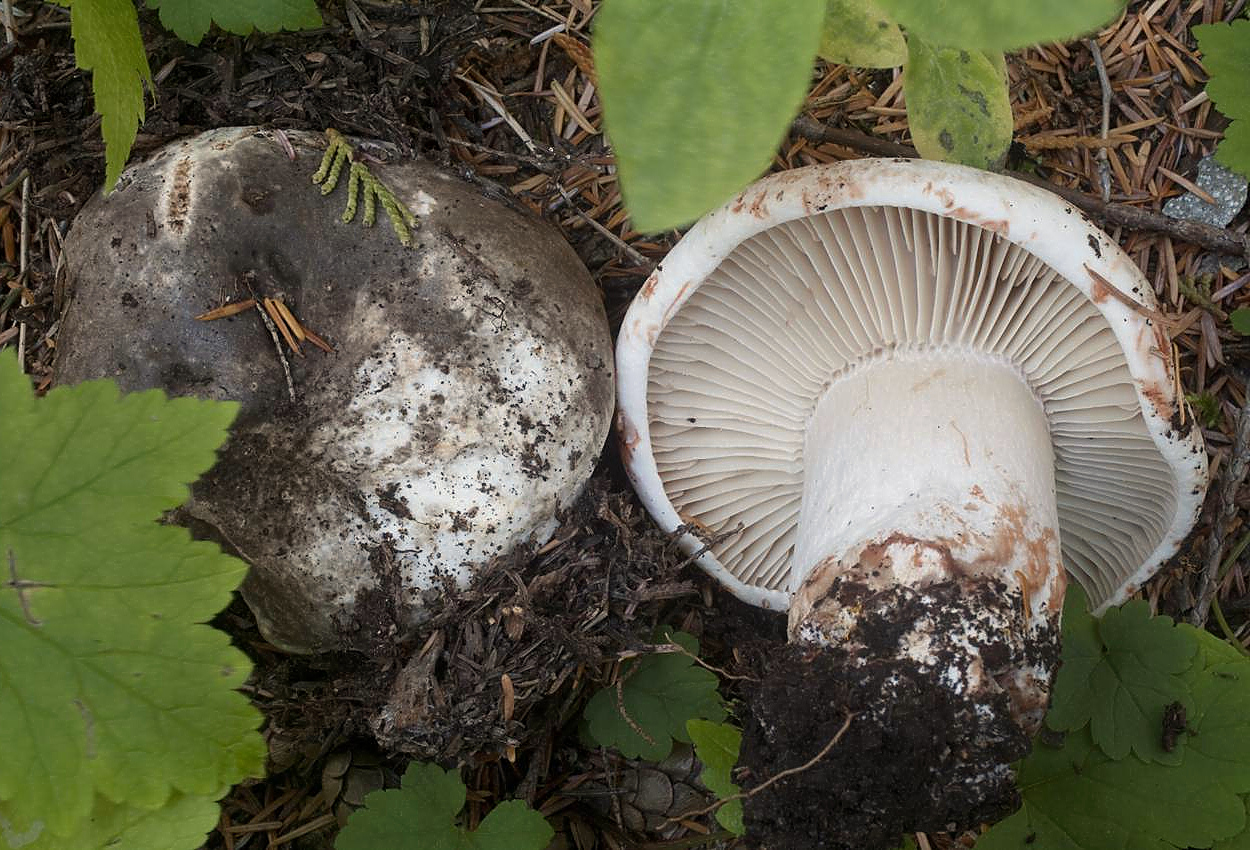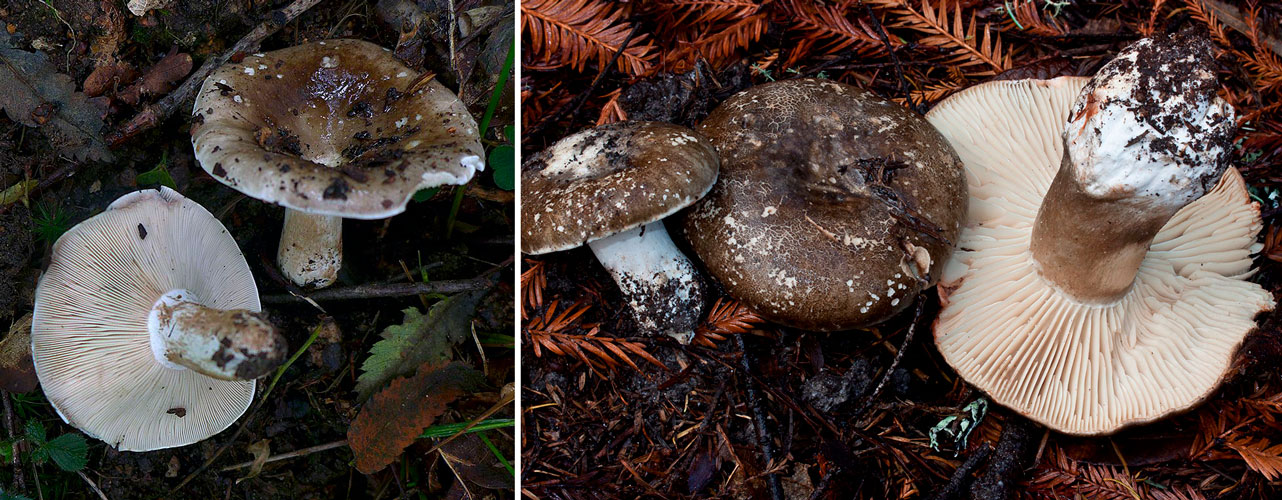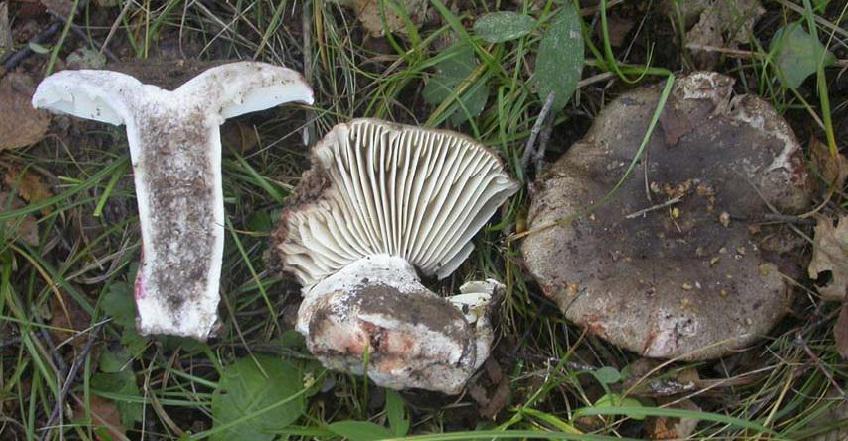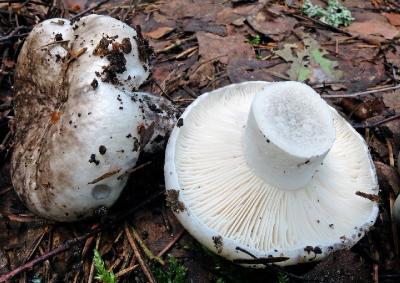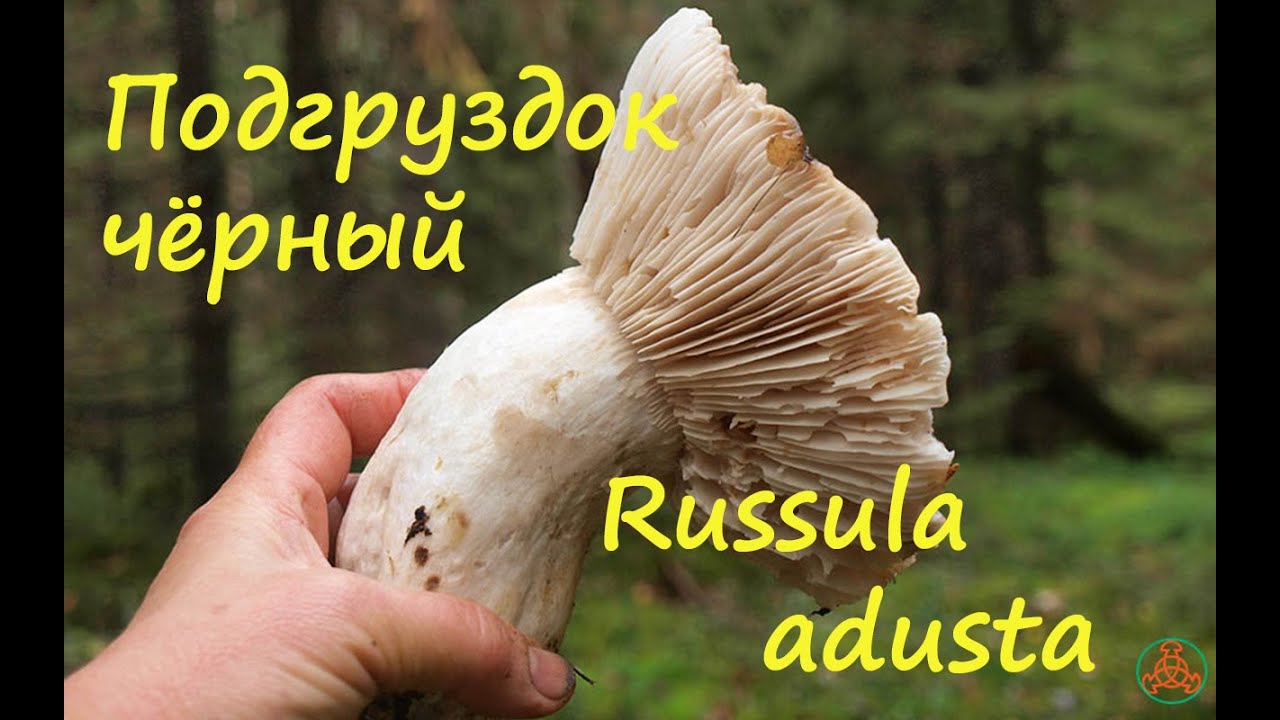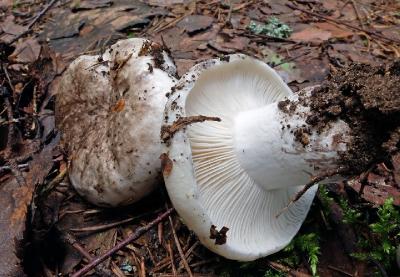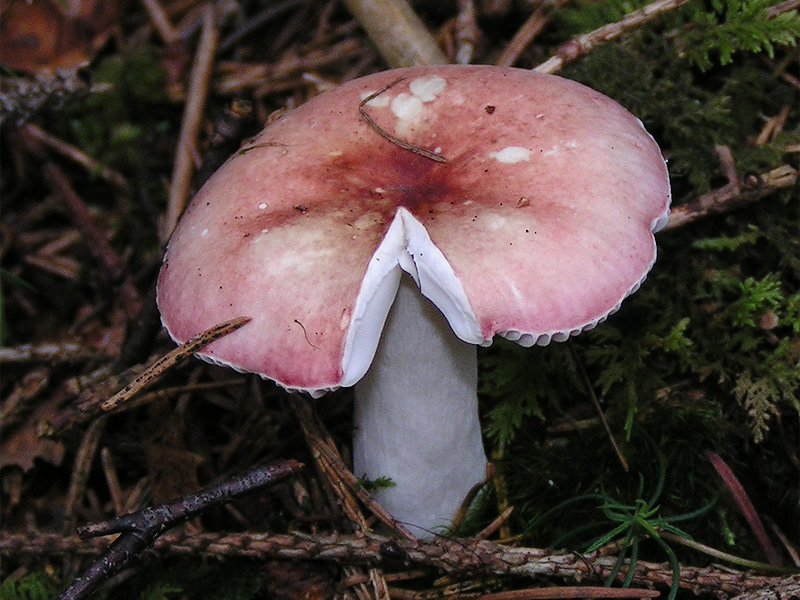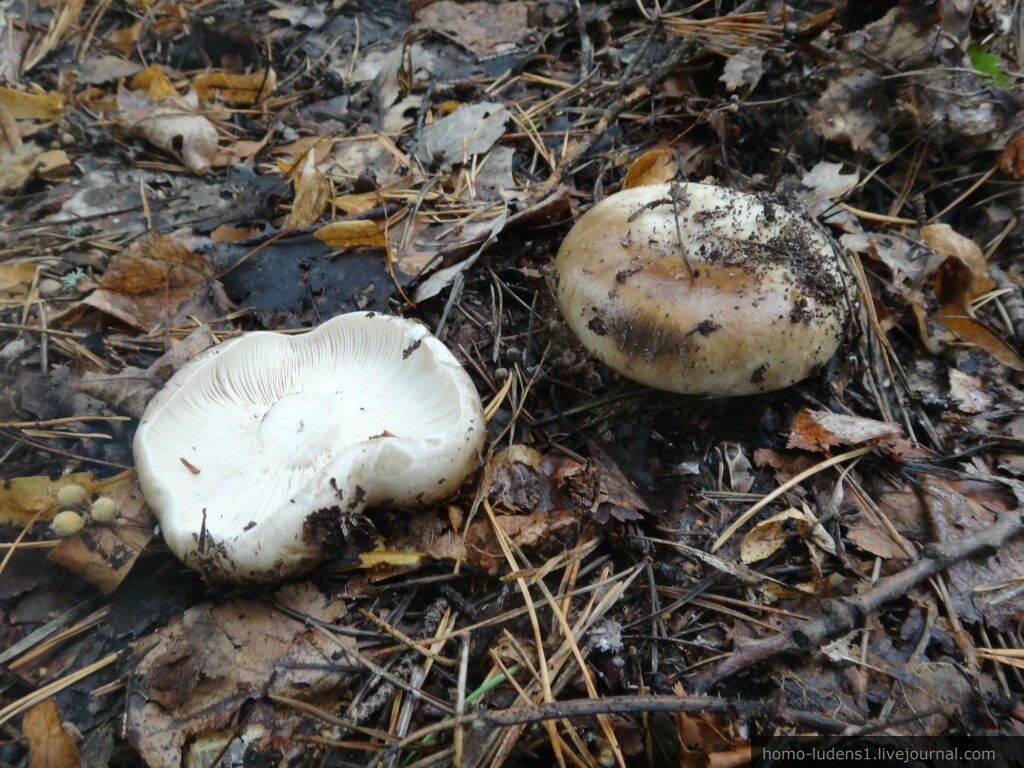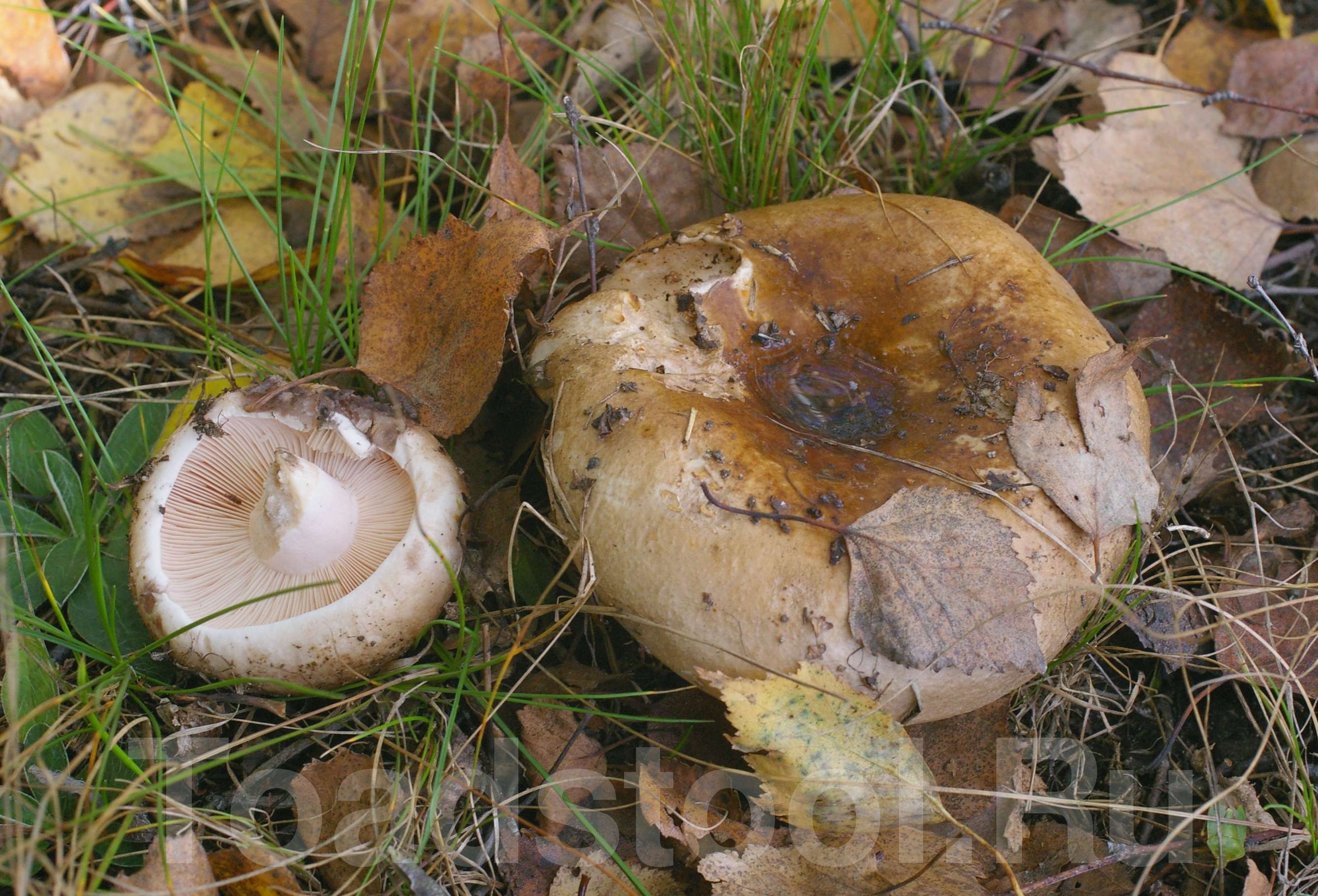False doubles
Inexperienced mushroom pickers can easily confuse white with its counterparts, but they are all edible
It is important to be attentive to forest finds and prepare them correctly. The differences are shown in the table.
| Name | Hat | Hymenophore | Growing places | Danger |
Load white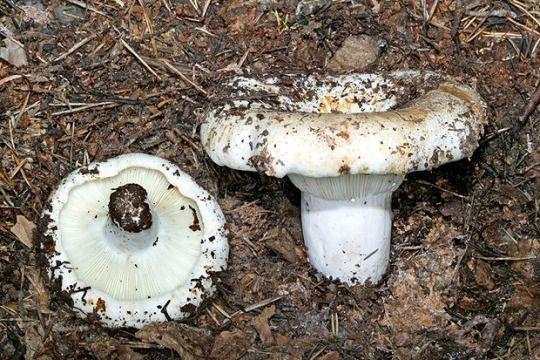 |
White with yellow or reddish spots, dry, bitter | Frequent plates, cream, closer to the center of a bluish tint | Grows on forest edges, occurs next to deciduous and coniferous trees | Conditionally edible, taste is bland |
Greenish-lamellar loading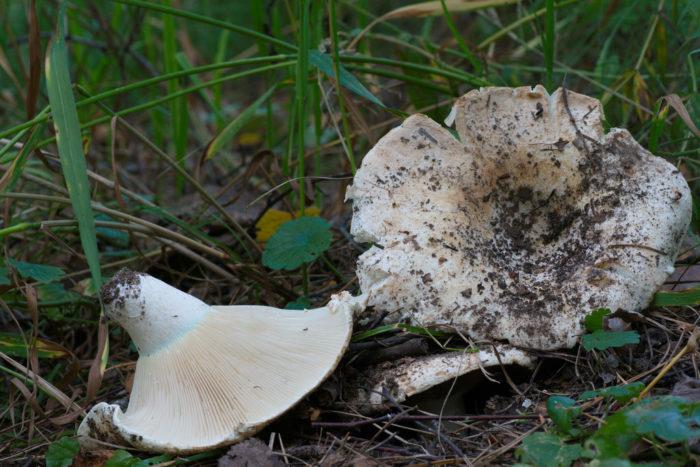 |
White, creamy, ocher, with age with rusty spots | Bluish green tint | Deciduous forests of Western Siberia | edible |
Violinist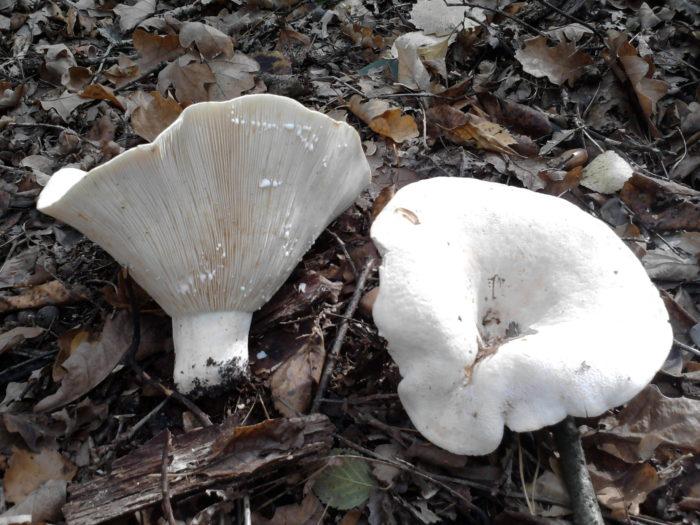 |
White with a pile, secretes milky juice | White, rare, interspersed with short | Deciduous and coniferous forests, birch | Conditionally edible |
Real milk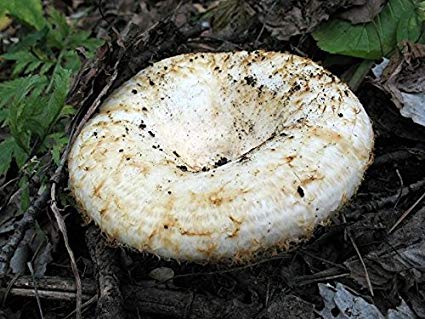 |
The surface is mucous, youthful or yellow in color, secreting milky juice | Yellowish tint, often located, wide | Prefers deciduous or mixed forests, grows in the north of Russia, in the Volga region, the Urals. | Conditionally edible |
Volnushka white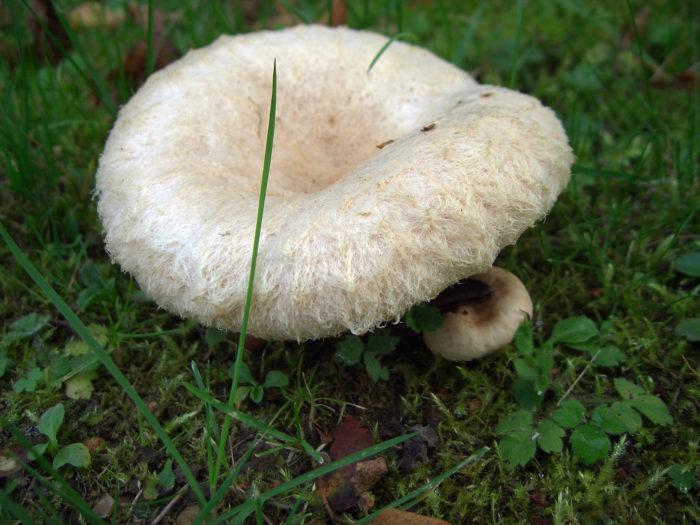 |
There is a small amount of mucus on the surface, fluffy | Adherent, narrow, often located | Most often found near birch | Conditionally edible |
Dry milk has no poisonous and dangerous counterparts, and therefore you can safely put it in the basket and enjoy it. The main difference between the mushroom and others is the absence of milky juice and a dry cap.
White podgruzdok (Russula delica)
Synonyms:
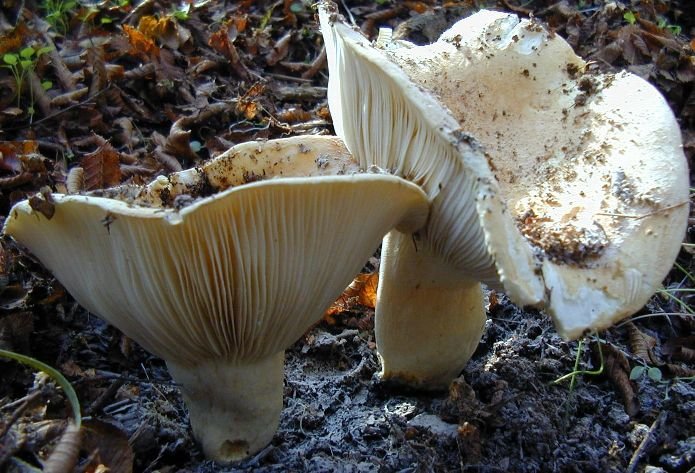
This mushroom is included in the genus Russula, belongs to the family Russula. Sometimes such a mushroom is called "Dry Milk", "Rusk". This one is because, like two drops of water, it looks like a common lump, but unlike it, it has only a dry cap.
White podgruzdok belongs to large mushrooms. There are specimens reaching cap sizes and up to thirty centimeters in diameter (although they are quite rare). It has a flat-convex shape, in the center there is a characteristic fossa. The edges of the cap are somewhat curved. Young mushrooms of this species have a predominantly white cap. At times, a rusty coating may appear on the cap. But the old podgruzdki are always only brown.
The cap of this mushroom changes its appearance, color depending on the age of the mushroom. Podgruzdok is white. If the mushroom is young, then the cap is convex, and the edges are wrapped. It is also characterized as "slightly tomentose". Further, the cap begins to become covered with spots: first of an indistinct, yellowish color, and then - ocher-rusty. A huge amount of earth, dirt, debris adheres to the hat, which is why it additionally changes its color.
The mushroom plates are thin, narrow, usually white. At times they are turquoise or greenish-blue. It is easy to notice if the cap is tilted a little.
The white podgruzdok is distinguished by its leg. It is strong, white, like the hat. It is decorated with oblong brown spots. Bottom wide, it gradually tapers upwards.
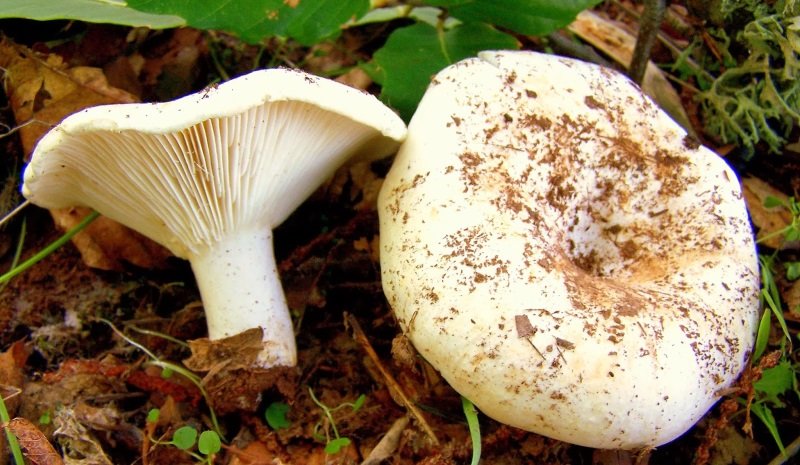
White podgruzdok has a white, juicy pulp that gives off a pleasant strong mushroom aroma. The spore powder of such a fungus has a white, occasionally creamy shade.
The mushroom is edible. But the taste is pretty mediocre. It should be used salted and only after thorough boiling - not less than fifteen or even twenty minutes. It can be salted and dry.
The mushroom grows from mid-summer to early October. Its habitat is birch, aspen, oak forests, mixed forests. Much less common in coniferous forests. In general, this is a fairly common type of mushroom throughout Eurasia.
Similar species
- Short-legged russula (Russula brevipes) - common in North America.
- Chlorine russula or greenish russula (Russula chloroides) - lives in shady forests, often it is included in the species of podgruzdok. Has plates of bluish-green color.
- Pseudo-luxurious russula - grows under oak trees, has a yellow hat.
- Milky - has a milky sap.
The white diaper mushroom looks like an edible fiddle. It differs from it in the absence of white juice, bluish-green plates. The mushroom differs from the edible pepper mushroom in more frequent small plates, and it also has no juice of a milky consistency.
Primary processing and preparation
As already mentioned, white podgruzdok is consumed in salted, less often pickled form. Mushrooms are pre-soaked in cold water (4-5 hours, so the process of cleaning from litter will be easier). After that, you should remove the debris with a brush and boil the load for a quarter of an hour in slightly salty water. When they have cooled down (to speed up the process, you can put them in cold water), you can start pickling or salting.
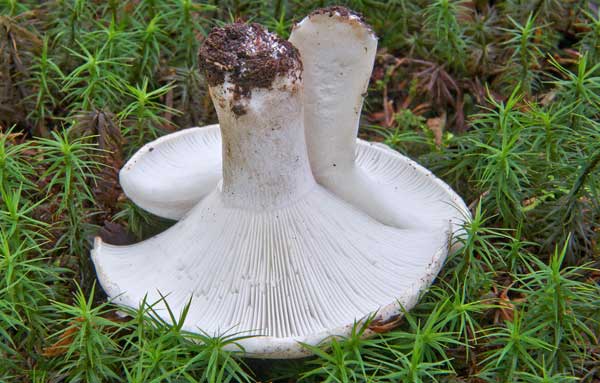
There are two ways to salt dry milk mushrooms.
- At the first, fast, mushrooms are boiled with salt and spices for 20 minutes. After that, citric acid or vinegar is added (these ingredients will replace the natural lactic acid that forms during fermentation), and the load is transferred to a container of cold water to cool them. After 10 minutes they will be ready for use.
- The second method is used for long-term storage. The loads are placed in a container in layers, each of which is sprinkled with salt, and filled with water (the entire mushrooms should be under it). Having put them in a warm place under oppression, you need to wait a few days until the water stops foaming (as a result of fermentation, lactic acid is formed, thanks to which the mushrooms acquire their unique taste), and then rinse the mushrooms again, put them in jars and pour, again the same, previously prepared brine. Always store in a cool place, such as a refrigerator.
Soups are also made from white podgruzdki and fried like ordinary mushrooms.
Despite the fact that dry mushroom is a rather bland mushroom, it is worth collecting, if only because tracking down their underground shelters is a great pleasure. And you can give it a very different taste if you prepare the brine correctly.
Places of growth of black russula.
Mostly black russula grow in pine forests. They settle in groups. Chernushki grow under the pines. Fruiting of nigella is observed from July to October. Black russula are common in mixed, deciduous forests and conifers.

Evaluation of the edibility of nigella.
Black russula are edible, but they are not very tasty, they are classified in the 4th category. During salting, they turn black. Their taste is sweetish, pleasant. They are also boiled and stewed. It is recommended to soak the russula before cooking. These mushrooms go well with fried and stewed vegetables. And salted russula are considered a delicacy. Salted russula are ready in a day. They go well with other types of mushrooms.
Fried russula taste like many other types. Black podgruzddki can be served as a separate dish or with side dishes. Some connoisseurs make chops from them. But it is not recommended to add russula to soups, as they give the dish a bitter taste.

Properties and benefits of black pads.
The composition of black russula contains vitamins B2 and PP, as well as carbohydrates, fats and proteins. These mushrooms are antibacterial. The calorie content of black russula is low, so they are suitable for dietary nutrition, but at the same time they are nutritious and well satisfy the feeling of hunger, without creating discomfort in the stomach.
Russula are indicated for people with gastrointestinal diseases. They help with blood clots and prevent the risk of blood clots. In addition, russula curdled milk, creating a healing fermented milk product from it. Such a product is useful for people with cardiovascular diseases.

Related species.
The russula pink is a conditionally edible relative of the black podgruzka. Her hat is semi-circular. Its surface is smooth, dry, velvety. The color of the cap can be dark pink or red. The leg is cylindrical, thick, white with a pink tint. The pulp is firm but fragile.
Pink russula grow in deciduous forests, rarely found in conifers. These mushrooms can settle in mountainous regions. Fruiting of pink russula is observed in summer and autumn.

Turkish russula is an edible mushroom. The shape of the cap is convex, flattened or depressed. Its color is most often purple, but it can be gray-purple. The stem can be cylindrical or clavate, white or pink in color. The pulp is dense, white, with a sweetish taste and pleasant smell.
These mushrooms grow in European coniferous forests. Turkish russula settle under spruce and fir trees. They grow singly or in small groups.
Macroscopic description of white loading
Basidiocarps (fruiting bodies) of Russula delica do not seem to want to leave the mycelium, and often fungi are found half-buried and sometimes growing hypogenically. As a result, the caps, during the growth of the fungus, often capture the surrounding leaf debris and soil with rough surfaces.
p, blockquote 3,0,0,0,0 ->
Hat
White podgruzdok - hat
Has a noticeable size, from 8 to 20 cm in diameter. At first, it is convex with a central depression, rapidly develops into a funnel. Cuticle is white, creamy white, with buffy yellowish tones and more prominent spots on mature specimens. The flesh of the cap is dry, thin, dull, difficult to separate, smooth in juveniles and rough in mature specimens. The edge of the cap is spiral, lobed. The hat is often strewn with traces of dirt, grass and leaves.
p, blockquote 4,0,1,0,0 ->
Hymenophore
p, blockquote 5,0,0,0,0 ->
The gills descend to the pedicle, brittle, wide, ventricular, moderately dense, with lamellas. Their color is white, slightly creamy, the plates are slightly ocher colored when damaged. Sometimes they secrete clear sap like water droplets.
p, blockquote 6,0,0,0,0 ->
Leg
p, blockquote 7,0,0,0,0 ->
Cylindrical, short in relation to the diameter of the cap, from 3 to 7 in length and from 2 to 3 cm in diameter, hard, brittle, continuous, without a central cavity. The color of the leg is white, cream-colored at maturity.
p, blockquote 8,0,0,0,0 ->
Mushroom flesh
Dense, brittle, white, with time acquiring a yellowish tint. Her smell is fruity in young specimens and somewhat unpleasant, fishy in overripe mushrooms. The sweet taste becomes somewhat spicy, especially in the gills, when ripe. People find the white flavor to be spicy, spicy.
p, blockquote 9,1,0,0,0 ->
Chemical reaction: Ferrous sulfate changes the color of the flesh to orange.
p, blockquote 10,0,0,0,0 ->
Spores: creamy white, ovoid, with a delicate warty pattern, 8.5-11 x 7-9.5 microns.
p, blockquote 11,0,0,0,0 ->
Vyacheslav stepanov: mushrooms of the kaluga region - black podgruzdok (russula adusta)
Common names
Common names
Cap Hat: 5-10 (15) cm in diameter, first convex, then convex-outstretched with a bent, later raised edge, slightly depressed, sometimes funnel-shaped, often strongly wavy-bent, sticky, at first pale yellow, pale brownish, grayish-brownish , then dirty brownish, brown, brownish brown, darker in the middle, with a light, almost white edge, with numerous adhering particles of earth and debris.
Gills: Medium frequency, slightly descending, whitish at first, then dirty gray, with dark brown and black spots, pungent taste, darkens when pressed. Controversy
Spores Spore powder white.
Stem Leg: short, 3-5 cm long and 2-3 cm in diameter, cylindrical, dense, solid, then finished, whitish, then grayish, darkens when pressed. Pulp
Flesh Pulp: dense, then loose in the stem, brittle, white, then grayish, on the cut it turns gray and darkens almost to black, in old mushrooms it is almost black with a weak unpleasant sour smell, very often becomes wormy, starting from the stem. Fruiting calendar
Calendar
Accepted designations / Legend
- the appearance of single mushrooms / seldom
- layers of poor fruiting / not much
- periods of stable, massive fruiting / a lot
The divisions on the time scale correspond to five days of the month
Ticks on the time axis correspond to the five-day weeks of the month Habitat
Habitat Habitat: from early July to October in deciduous (with birch), coniferous and mixed (with pine) forests, in bright places, glades, along paths, in groups, not infrequently, annually. More common in more northern forested regions Edible
Edibility
Edible or conditionally edible mushroom (4 categories), used salted, sometimes (after thorough washing!) Pickled (after boiling for about 15-20 minutes). Before boiling, some mushroom pickers soak to soften the acridity of the plates. In the workpieces it turns black.
Mushroom Pictures On The Internet
Other photographs of this mushroom in the WEB
Remarks
Addition: young mushrooms follow, and not because they smell nicer, but because it is almost impossible to find a large and non-wormy mushroom. Old mushrooms are finally black and thoroughly eaten, rot for a week or two, standing out on the grass in a black handful. There are three more types of half-load with blackening pulp: blackening podgruzdok (see below), Black-and-white podgruzdok (Russula albonigra) with a whitish, dirty-grayish cap and rapidly blackening pulp, rarely found in autumn in birch and spruce forests; Russula densifolia with a brownish-brown cap and very frequent lamellae (characteristic) with reddening and then blackening flesh and a pungent taste, rarely found in autumn in coniferous and deciduous forests, all of which are used in salty form Mentioned in reports
Sergei Appolonov dated July 26, 2004
Kirill Bykov from 11.09.2004
Yuri Semenov dated July 28, 2002
Yuri Semenov dated 08.25.2002
Yuri Semenov dated July 14, 2003
Yuri Semenov from 08/11/2003
Report by Stanislav Sviridov dated 06.10.2002
Places of growth of blackening podgruzdkov.
Blackening russula form mutually beneficial alliances with hard tree species, this cooperation is called mycorrhiza. Blackening podgruzda grow in mixed and deciduous forests. In addition, they are often found in deciduous and spruce forests.

Blackening pods can develop in the substrate, and when they mature, they come to the surface, from this their caps are often covered with earth and debris. Under natural conditions, they decompose slowly, when this happens, the fruit bodies turn black. Dried specimens can persist for a long time, even until next year.
The temperate strip is a favorite growing area; they are also common in Western Siberia. This species is not uncommon in Western Europe.
In the forests, they settle in large groups. Fruiting in blackening podloads begins in mid-summer, and ends almost in winter. These mushrooms tolerate cold well and are even found in the northern region - on the Karelian Isthmus.

Podgruzdok black white and blackening: description of the mushroom and what a dry milk mushroom looks like in the photo
Active growth requires a lot of light and little heat. This mushroom grows in huge quantities in deciduous and mixed forests of the middle zone of our country. Usually, its mycelium dislocations are located near aspens and birches. It is these trees that create the most favorable conditions for their existence.
Podgruzdok popularly has a simpler name. This is a dry lump. It is not by chance that the mushroom is called that. In from common mushrooms, they are never covered with mucus and do not become wet. The surface of their caps is always dry and slightly rough to the touch.
A regular load looks like this. This is a fairly strong cap with edges bent inward and up to 20 cm in diameter. The upper surface of the cap is matte white with yellowish blotches. During the growth process, the fungus is prone to cracking. A characteristic feature is the absence of milky juice on the cut of the stem and cap. Podgruzdok or dry lump belongs to the second category of edibility.It can be used for salting and pickling without first soaking in water
Podgruzdod black or black
From the beginning of July to the very end of October, the coniferous and deciduous forests of our country can delight you with a rich harvest of another type of dry milk mushroom. This is a black load. It is also called black russula. And this is no coincidence. Outwardly, the black podgruzdok really resembles a russula. The hat is up to 15 cm in diameter and has a glossy dark blue, almost black surface. There is no milky juice.
Black podgruzdok can be eaten boiled, fried and salted. Does not require soaking before direct use.
Podgruzdok porcini and mushroom rusk
Podgruzdok porcini and mushroom rusk are the names of the same specimen. This is a type of mushrooms and lamellar mushrooms that grow in large numbers in bright places in deciduous forests. They can be eaten without boiling or steeping. They are distinguished by the absence of bitterness and unpleasant taste. belong to the category of little-known. But don't neglect them. They contain a fairly large amount of protein and various active substances that improve digestion. Dry milk mushrooms make an excellent powder for sauces and seasonings.
What does a blackening load look like
Blackening podgruzdok is another type of lamellar mushrooms that are found by mushroom pickers in mixed and deciduous forests and at the same time go unnoticed. Many confuse them with poisonous and inedible due to their unsightly appearance. But let's try to figure it out.
There is a certain opinion among mushroom pickers that the edible lamellar must necessarily produce milky juice. Dry milk has no milky juice. And this does not mean that it is poisonous. The blackening podgruzdok in appearance resembles a real lump. But unlike him, over time, his cap and leg begin to turn black. Older specimens are almost black in all parts.
Frequent lamellar loading
In the photo Frequent plate podgruzdok
Another name for this species is lamellar black. It is found more often in the south of Russia, in coniferous, mixed or deciduous forests.
The hat is distinguished by a more grayish, sometimes brownish tint, which, with the growth of the mushroom, becomes olive, and sometimes brown. Its diameter is rarely more than 12 cm. In young mushrooms, the cap is sticky, with age it becomes dry. The leg is the same shade as the cap.
The pulp on the break turns red, then brown, and then turns black. This lump has light plates that do not reach its legs.
The taste is inexpressive, the smell is weak.
In medicine, an extract from a lamellar load is used. It has antimicrobial activity. To relax muscles in medicine, it is the properties of this type of mushroom that are used.
In the kitchen, the podgruzdok is often fried, broths are made, marinated and salted. The mushroom does not need to be pre-cooked.
Evaluation of taste and recipes
This mushroom is edible.
IMPORTANT: It is best to collect and eat young specimens, since the vast majority of old ones are wormy. The taste of nigella is assessed as low, it is recommended to cook it only together with other mushrooms.
Used for salting, pickling, stewing and frying. Turns black when salted
The taste of nigella is assessed as low; it is recommended to cook it only together with other mushrooms. Used for salting, pickling, stewing and frying. When salted, it turns black.
Primary processing
The mushroom must be peeled, rinsed, then thoroughly soaked or boiled for 15–20 minutes to get rid of the moldy smell and bitterness.
Hot salting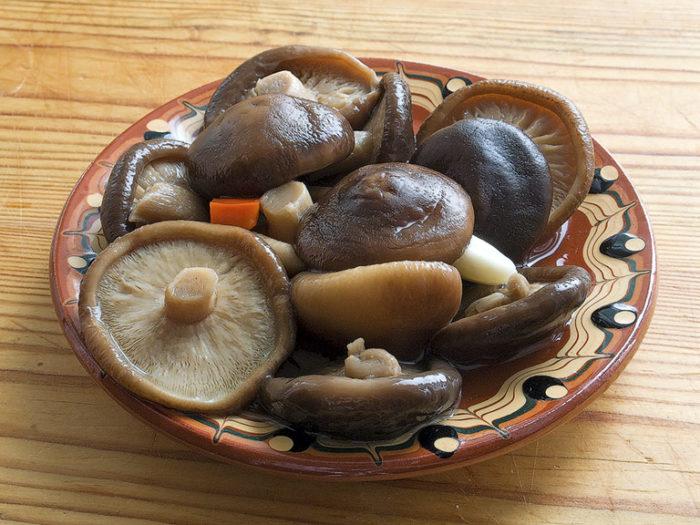
Ingredients:
- black loads (1 kg);
- salt (2.5 tablespoons);
- 120 ml of water;
- black peppercorns - 7-8 pcs .;
- cloves - 2 pcs.;
- 1 head of garlic;
- fresh dill.
Salting method:
- Pre-clean the pods from debris and soak them in cold water.
- Drain the liquid, add water again, put the mushrooms on medium heat and bring to a boil.
- Remove the resulting foam with a slotted spoon, add pepper and cloves. Cook until the mushrooms settle to the bottom and the brine turns light.
- Allow russula to cool, arrange in jars, shifting layers of mushrooms with dill and garlic. Pour with brine.
- Close the top with a lid with a load, keep in a cool place for a month and a half.
Growing method
White mycelium is sold in many specialty stores. Of course, you can make your own mycelium using an old specimen brought from the forest. But this method does not justify itself by a long wait for the harvest, moreover, it may not work at all, and therefore it is most convenient to purchase ready-made planting material.
Both live mycelium and dried mycelium are sold. The first is not stored for long, so it should be dropped off at the chosen place almost immediately. The second has an unlimited shelf life. Dry mycelium is more convenient and popular among gardeners and gardeners.
The material of one package is planted under a tree, and the area is usually up to three square meters. Next, step by step:
- A trench is dug up to 15 cm deep.
- At its bottom, the soil fluffs up.
- Mushroom planting material is evenly distributed over the surface.
- Everything is covered with earth mixed with humus. The proportions are kept in equal parts.
Then the site is covered with soil left over from digging out the recess. All tree species are suitable for planting. It can be produced at any time of the year, in the southern regions of the country, even in winter. The first crop will appear in spring or autumn, you can harvest up to 4 kg, but not earlier than six months after planting. In dry weather, the area should be watered abundantly. A mushroom box will last as many years as a tree, and can be harvested twice a year.
Black podgruzdok, Russula adusta
Hat: Diameter 7-15 cm, first flat-convex, then flat-concave, at first white-grayish, then unevenly colored, dark olive-brown, black. The pulp is grayish, thick, brittle, at the break it first turns red, then turns gray. The taste is sweetish.
Hymenophore: The plates are at first white, subsequently grayish, darken when pressed, adherent.
Spore powder: White.
Leg: Relatively short and thick, 3-7 cm in length, up to 3 cm in thickness, cylindrical, solid, of the same color with a cap or lighter, often with dark spots, darkens when pressed.
Spreading: Russula adusta is found in various forests from July to October, in good seasons - in large groups. Often it leads a semi-underground way of life, opening only in old age.
Similar species: There are enough similar mushrooms with gray caps and blackening pulp in the genus of russula. The differences are pretty minor. For example, blackening podgruzdok (Russula nigricans) - the pulp, upon contact with air, undergoes the same metamorphoses (from pink to dark gray), but rare plates. Russula albonigra turns black radically, without any flirting with the red part of the spectrum. R. acrifolia and R. densifolia have a distinctly bitter flesh and change color much faster. It is curious that in good conditions for themselves, black loadings of different types can grow intermixed, which gives a novice enthusiast-classifier especially exquisite pleasure.
Edibility: It is considered a good edible mushroom. Doesn't require any special measures.
Author's notes: As you certainly already know, Russula adusta is the record holder for worm attendance. (Only closely related species of black podloads can argue with him - or with her -) In our area, he is often found, especially at the beginning of fruiting, from mid-July to mid-August, but I can say without exaggeration: I still do not know what it tastes like.Once I found two (!) Completely non-wormy mushrooms in a very damp, dark and completely non-mushroom deciduous forest in the Tula region, but it so happened that already at the stage of preparation, these specimens were mixed with the rest of the mushrooms, and I could not find out that the same is found in this wonderful mushroom the larvae of mushroom flies.
Black podgruzdok differs from other blackening russules with difficulty. The frequency of the plates is one of the signs that make it possible to persuade the mushroom to the species Russula adusta. One, but not the only one.
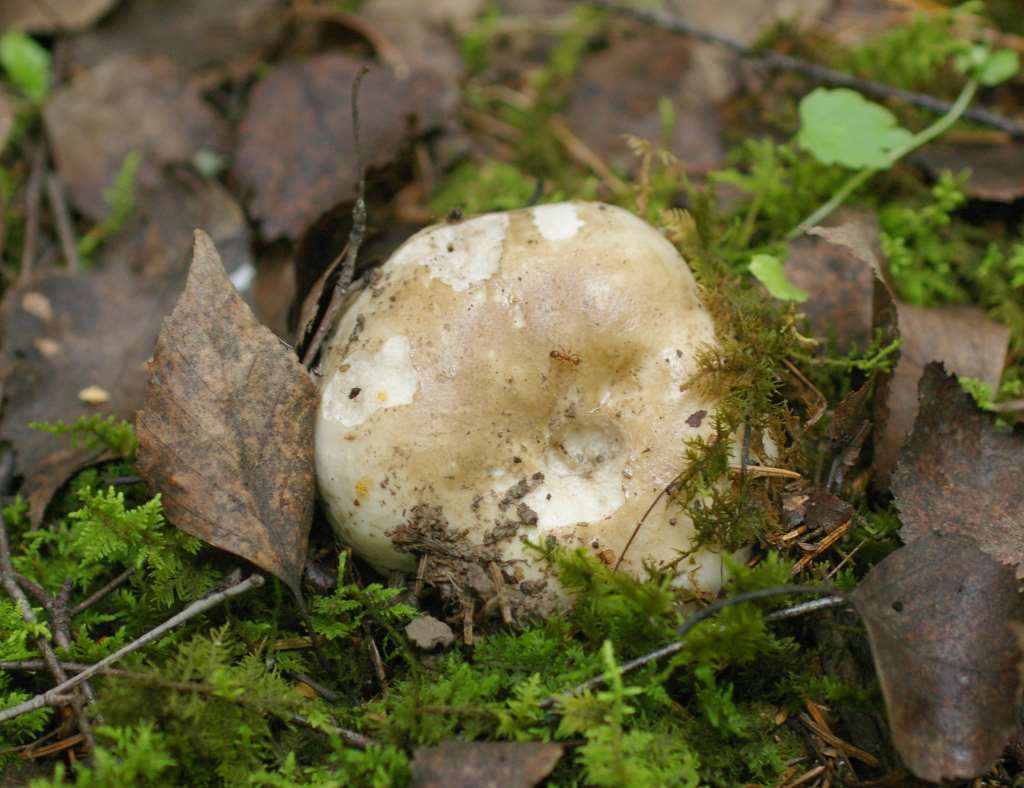
The mushroom, by the will of fate, has spent most of its life under a thick layer of litter, crawls out like this. And it's good if it comes out - a significant part of the black pods will never see the light of day. However, why light - mushroom flies will find it by smell.

It is possible that mushroom flies are guided, among other things, by aesthetic flies - even for a person who represents, in general, what is going on inside, this mushroom looks more than appetizing.
Description of loading black.
The shape of the cap in the black pod is initially convex, later becomes wide-funnel-shaped or deeply depressed. Its diameter is 5-15 centimeters, in rare cases it can reach large sizes - 25 centimeters. The color of the cap is dirty brown or dark brown. The surface of the cap is slightly sticky.

There are narrow plates under the head. They grow or run down the leg. The plates are of various lengths. They are located often. The color of the plates is first white, and later grayish, if you press on the plates, they turn black. The color of the spore powder is white.
In young specimens, the flesh is dense and thick, while in older specimens it becomes brittle. The flesh of the nigella on the cut turns red, and then slowly turns gray. From the touch, it turns black. It tastes sweetish-spicy, not pungent, its smell is strong, characteristic, reminiscent of old wine barrels or mold. The black russula does not have milky juice.
Load and value
The well-known Valui mushroom and the lesser-known black and white podgruzdok belong to the russula genus. They are characterized by a fragile leg. They are usually collected a little, since more valuable mushrooms are always found in the forest. The same mushrooms are conditionally edible. They are salted, less often pickled, but must be pre-soaked in cold water to destroy bitterness or boiled.
Podgruzdok black
This mushroom is also called black russula. It is found in all forests, especially in deciduous ones, it grows all summer from June to October in groups.
The cap is up to 15 cm in diameter, in a young mushroom it is convex, in a mature one it is depressed, with curved edges, dirty gray, later brown or black, sticky. The pulp is white, brittle, without milky juice, turns red at the break, then turns brown and finally turns black. The mushroom is very similar to the milk mushroom, although it belongs to the genus russula.
Black differs from all podgruzdok podgruzdok in that it does not have milky juice. The plates are adherent to the pedicle or descending, white, darken from pressure. The leg is up to 5 cm long, 2.5–3 cm thick, smooth, dense, of the same color as the cap. These fungi are severely damaged by insects.
Mushroom little-known, edible, 3rd category, eaten boiled and salted, turns black when salted.
Valuy
It grows in deciduous and mixed forests from July to October, occurs frequently and abundantly, and is one of the most common mushrooms in our forest zone.
The cap of a young mushroom is spherical, tightly attached to the stem, later straightens and becomes flatter, up to 8–15 cm in diameter, with a ribbed-striped edge, buffy-yellow or yellow-brown, very slippery in wet weather, and shiny in dry weather. The skin peels off easily. The pulp is dense, white, yellowish in old mushrooms, very bitter, with an unpleasant odor. The plates are adherent, in young mushrooms are white, in mature ones they are yellow or rusty-yellow with brownish spots and with droplets of transparent liquid. The leg is up to 10 cm long, up to 3 cm thick, sometimes thickened in the middle, white, loose, hollow.
Mushroom conditionally edible, 3rd category.After boiling, it is suitable for pickling. It is recommended to collect young mushrooms with an unopened cap.
Podgruzdok white
Often and quite abundantly found in coniferous and deciduous forests, it grows mainly under birch and aspen trees from July to October, it differs from all mushrooms in that it does not have milky sap. The hat is the same as that of a real breast, only its edges are not fringed, and on top it is always dry and often with adhered earth, up to 20 cm in diameter, matte, white, sometimes with yellow-brown spots. The pulp is white, dense, does not change color at the break. Descending plates, frequent, thin, bluish-white. The leg is white, in a young mushroom it is even, solid, later it becomes hollow.
Conditionally edible mushroom, 2nd category, it is salted and pickled, but pre-soaked.
Blackening podgruzdok (Russula nigricans)
Russula blackening
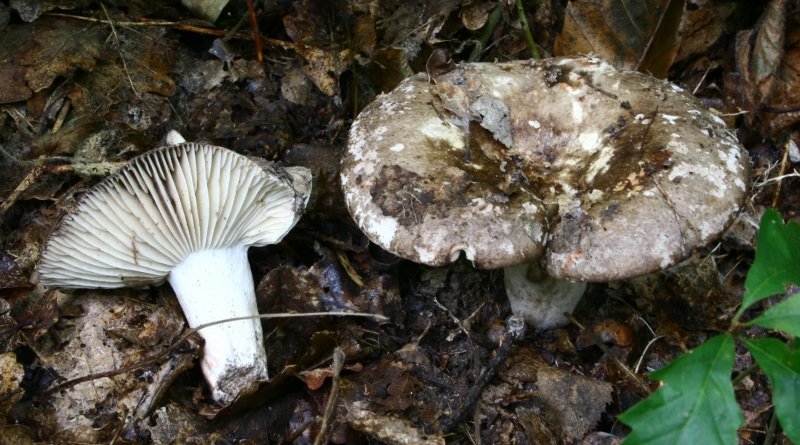
Blackening podgruzdok - a type of mushroom included in the genus russula, belongs to the russula family.
It has a cap from 5 to 15 centimeters (sometimes larger specimens are found - even up to 25 centimeters in diameter). At first, the cap is whitish in color, but then it becomes dirty grayish, brown with a shade of soot color. There are also brownish specimens with an olive tint. The middle of the cap is darker and the edges are lighter. On the cap there are adhering particles of dirt, earth, forest debris.
The blackening podgruzdok has a smooth, dry cap (sometimes with a slight admixture of mucus). It is usually convex, but then becomes flat and spread. Its center becomes smooth over time. Cracks may form on the cap, which expose a beautiful white flesh.
The plates of the fungus are thick, large, and sparsely located. At first they are white, and then they turn gray or even brownish, with a pinkish tint. There are also atypical black plates.
Leg Loading blackening - up to 10 centimeters. It is strong, cylindrical in shape. As the fungus ages, it becomes a dirty brown color.
The pulp of the mushroom is thick, breaking. Usually white, slowly turns reddish at the site of the incision. It has a pleasant taste, slightly bitter, and a pleasant weak aroma. Ferrous sulfate turns this pulp pink (then it turns green).
Distribution area, growing time Blackening podgruzdok forms mycelium with hard tree species. Grows in deciduous, mixed forests. Also, the mushroom can often be seen in spruce and deciduous forests. A favorite place of distribution is the temperate zone, as well as the region of Western Siberia. The mushroom is not rare in Western Europe either.
In the forest, it is found in large groups. Begins to bear fruit in mid-summer, and this period ends until winter. According to the observations of mushroom pickers, it is found in such a northern region as the Karelian Isthmus, at the end of the forest it is not uncommon in the Leningrad region.
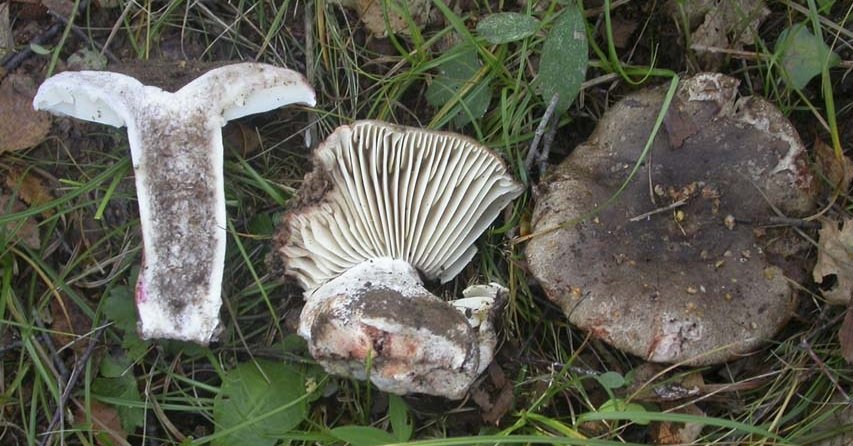
Mushroom twins
- Podgruzdok white and black (Russula albonigra). He has thick and falling plates, as well as a whitish hat, a grayish tint. The pulp of such a mushroom can turn black almost immediately. Redness is not visible in such mushrooms. In autumn, in birch and aspen forests, it is quite rare.
- Lamellar podgruzdok (Russula densifolia). It is distinguished by a brownish-brown and even brownish cap with a black tint. The plates of such a cap are very small, and the mushroom itself is smaller. The pulp first turns reddish, but then slowly turns black. In autumn, in coniferous and mixed forests, it is quite rare.
- The podgruzdok is black. When broken or cut, the flesh of this mushroom turns brown. But it has almost no dark, almost black shades. This mushroom is an inhabitant of coniferous forests.
These types of mushroom, as well as Podgruzdok blackening itself, form a separate group of mushrooms. They differ from others in that their flesh acquires a characteristic black color. Old mushrooms of this group are rather tough, and some of them can have both white and brown shades.
Is this mushroom edible? Blackening podgruzdok belongs to the fourth category of mushrooms. It can be eaten fresh (after boiling thoroughly for at least 20 minutes), as well as salted. In salty form, it quickly takes on a black tint. You need to collect only young mushrooms, since the old ones are quite tough. Moreover, they are almost always wormy. However, Western researchers consider this mushroom to be inedible.
Video about the blackening Podgruzdok mushroom:
Additional Information The fungus can grow in the substrate. Some old specimens of the fungus can come to the surface, this breaks the soil layer. The fungus can often be wormy. Another characteristic feature of the fungus is that it decomposes slowly in natural conditions. During decomposition, the mushroom turns black. Dried mushrooms persist for a long time, up to the next year.

